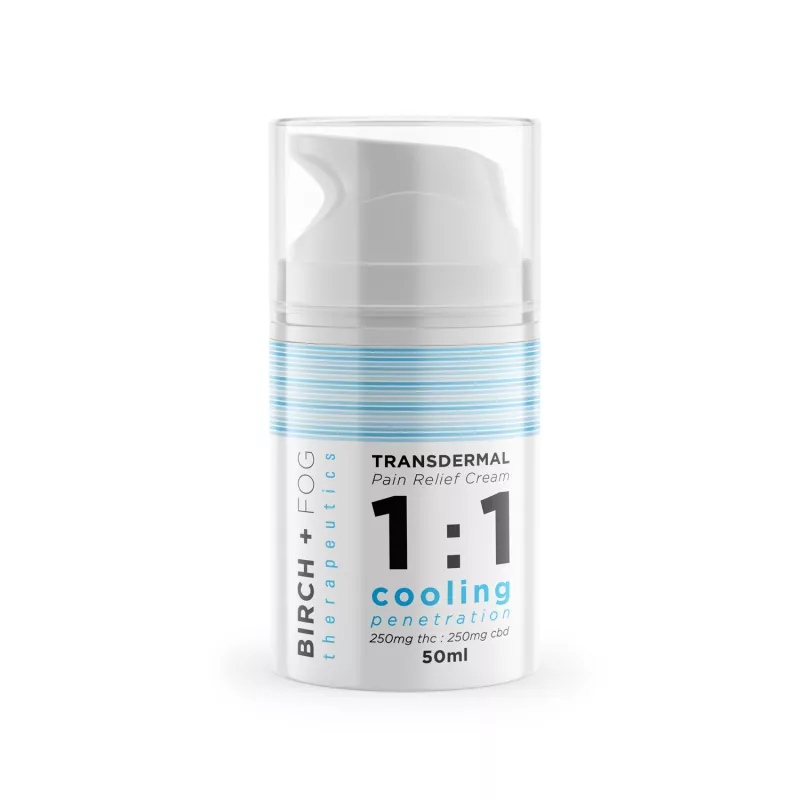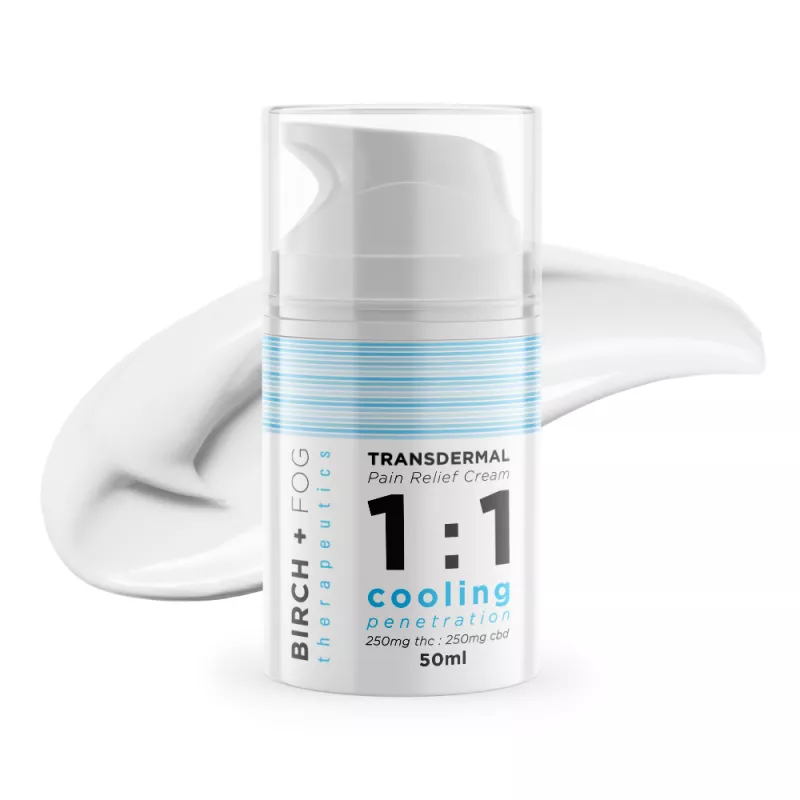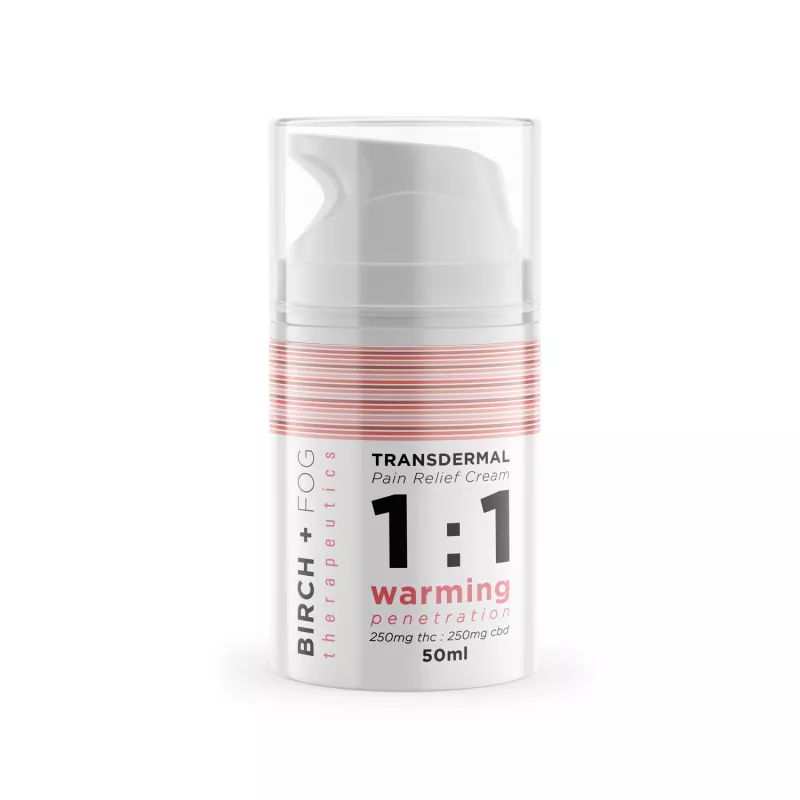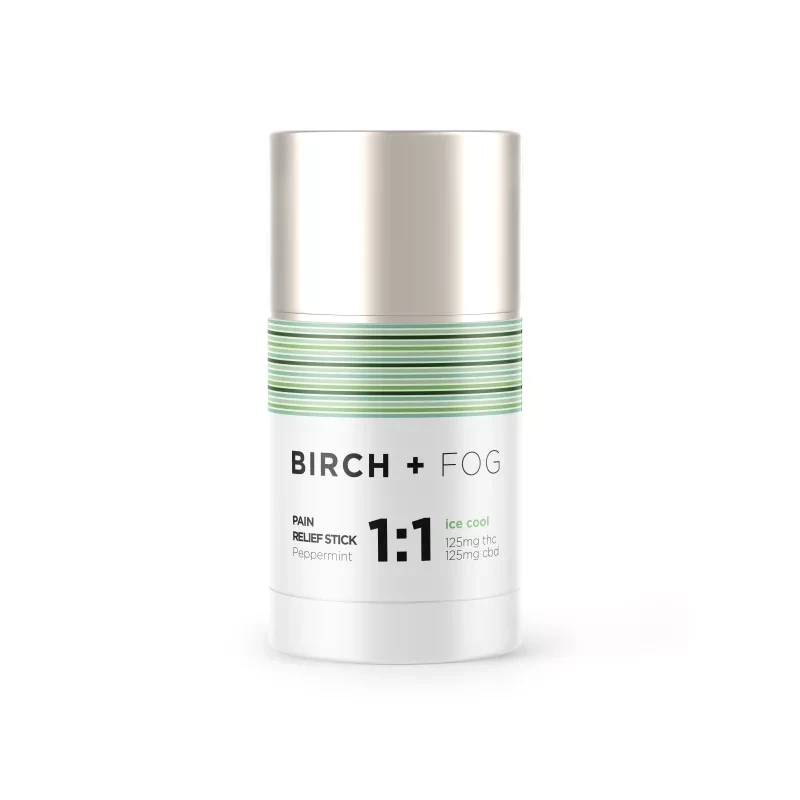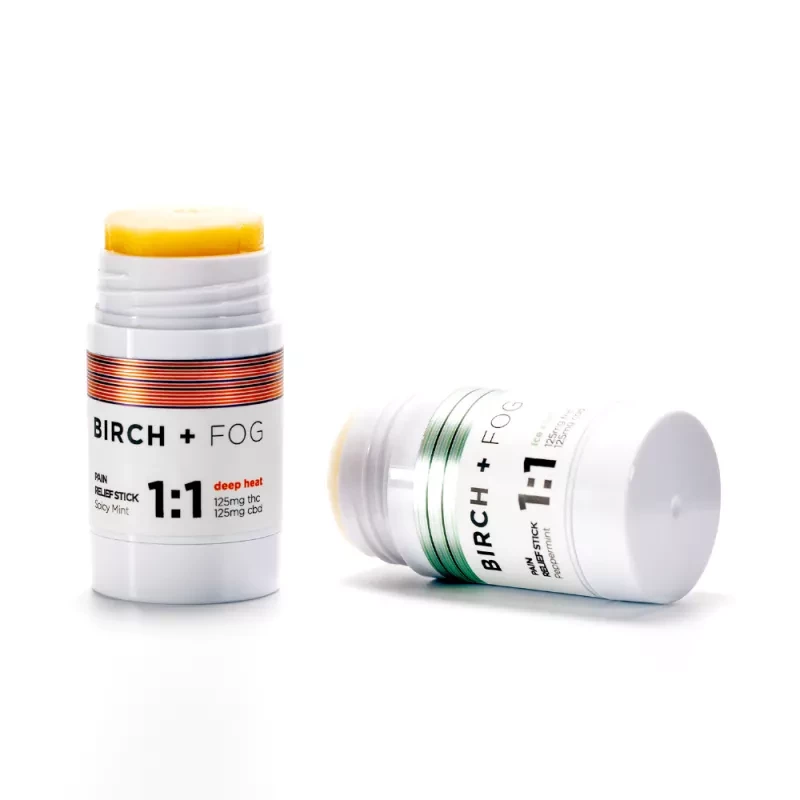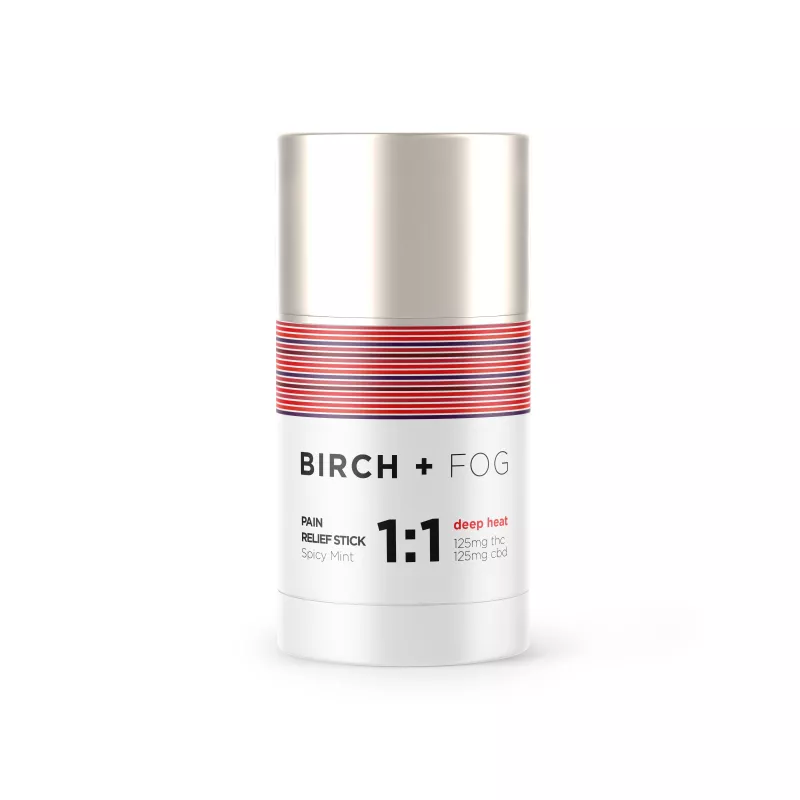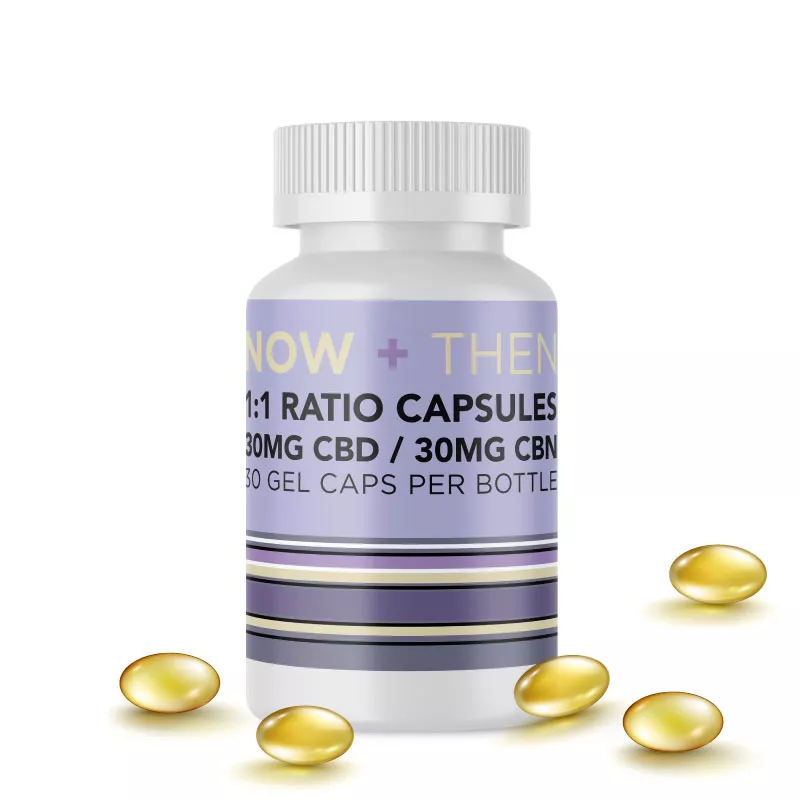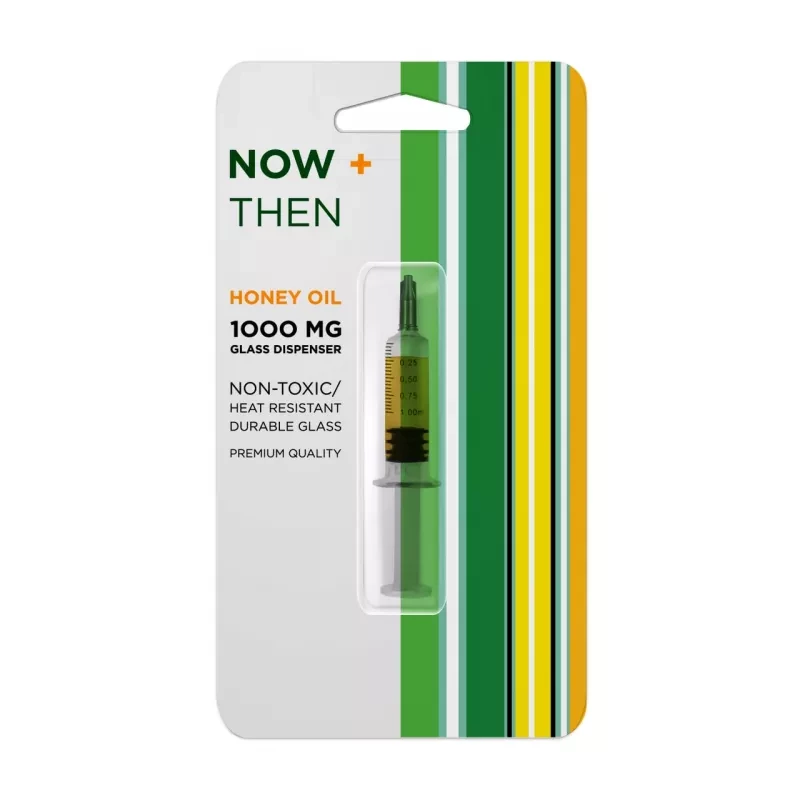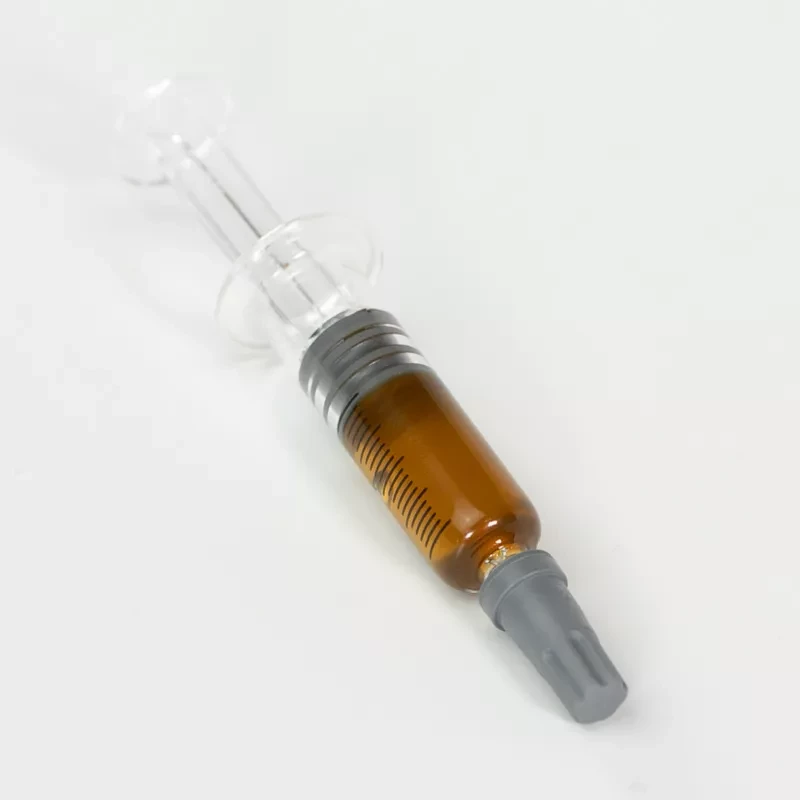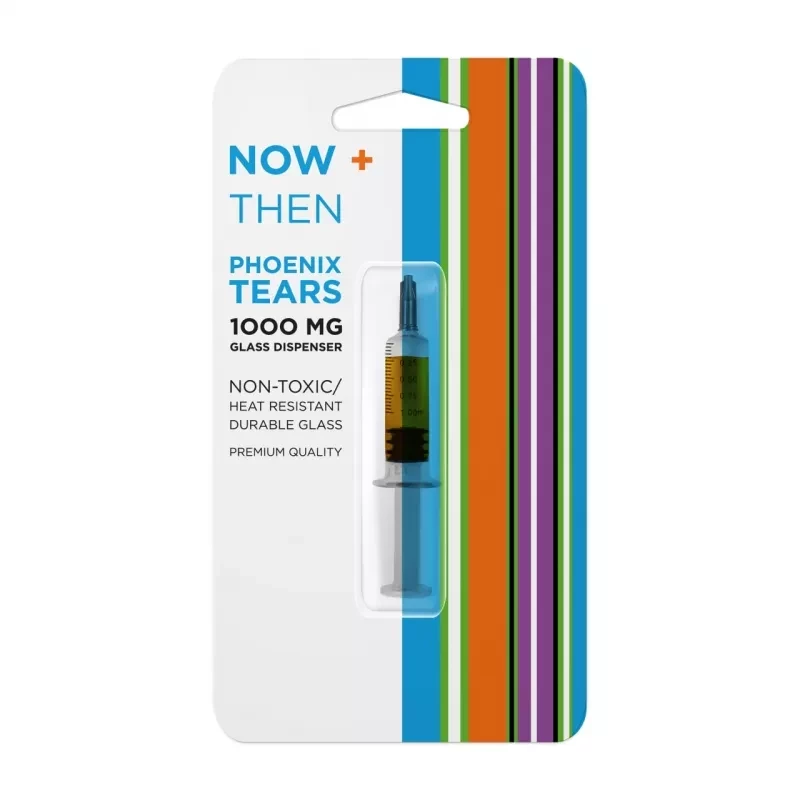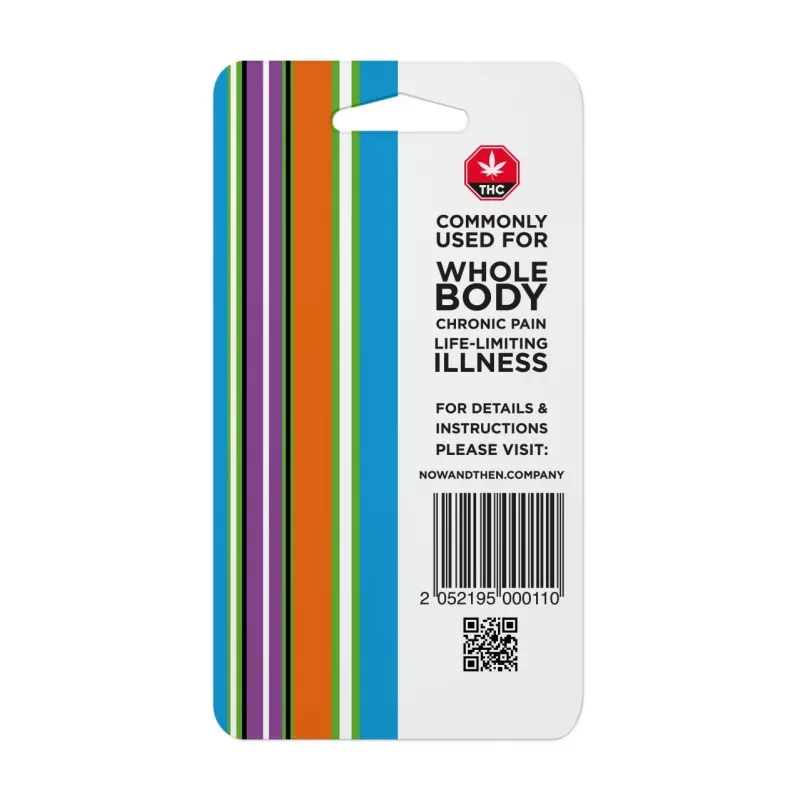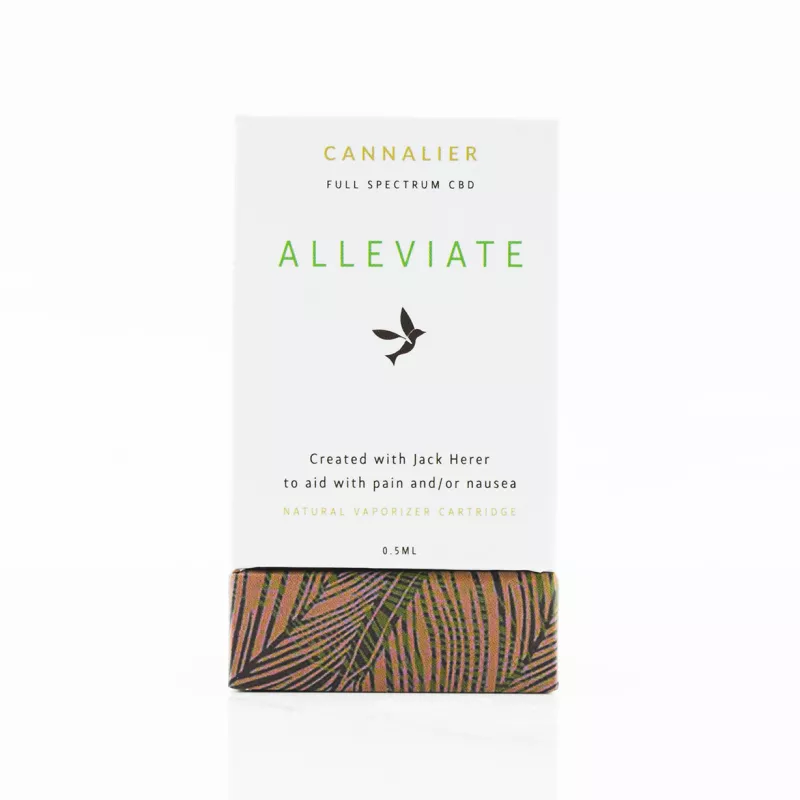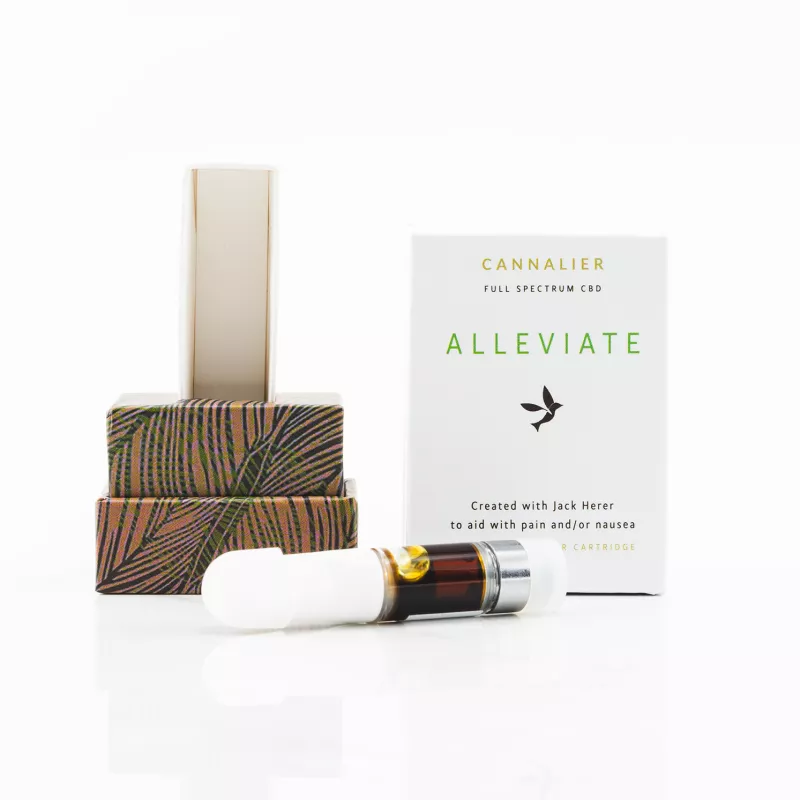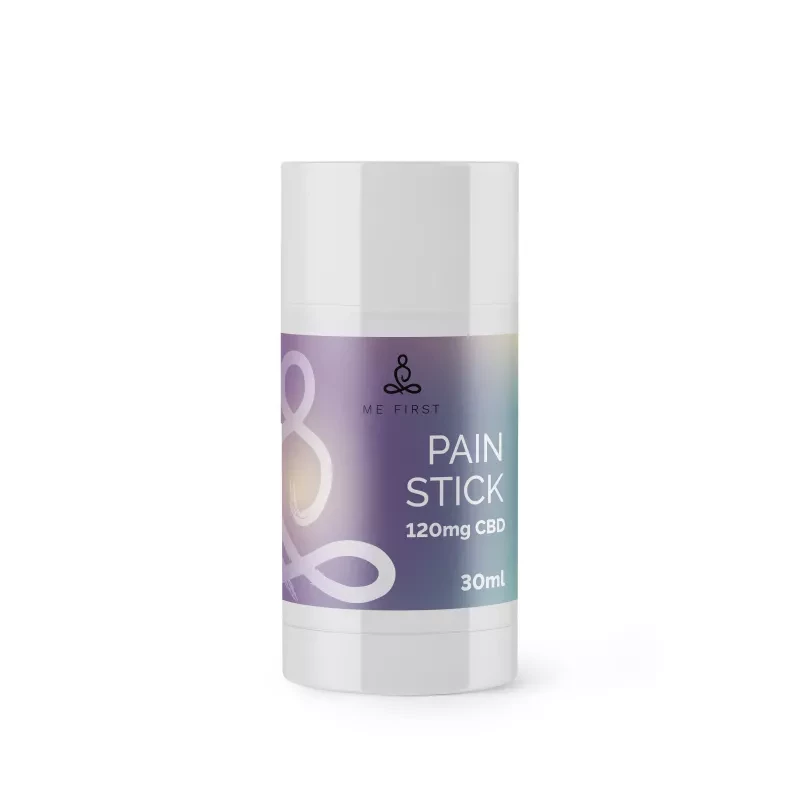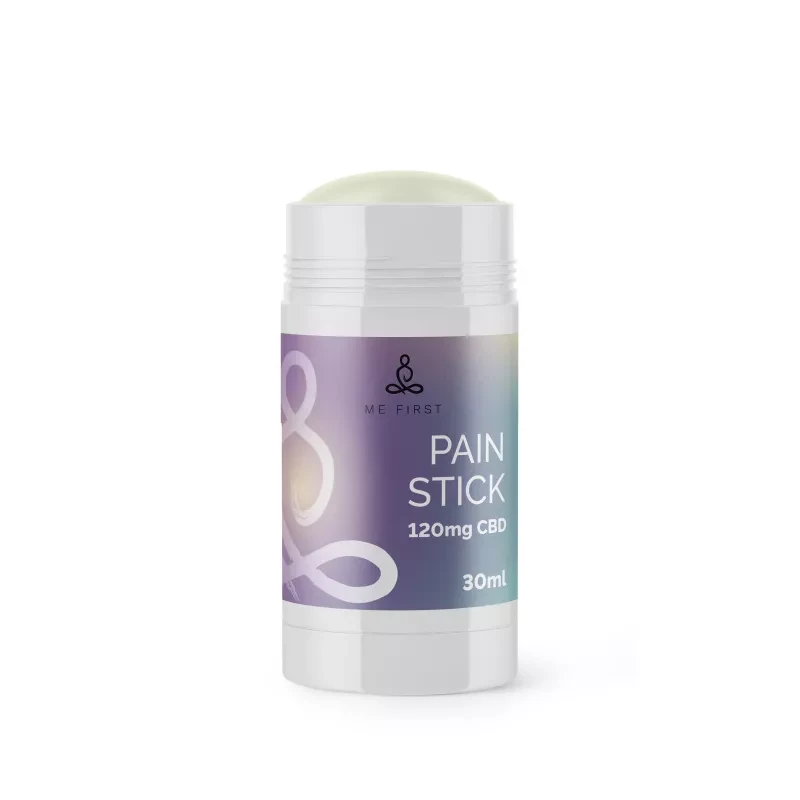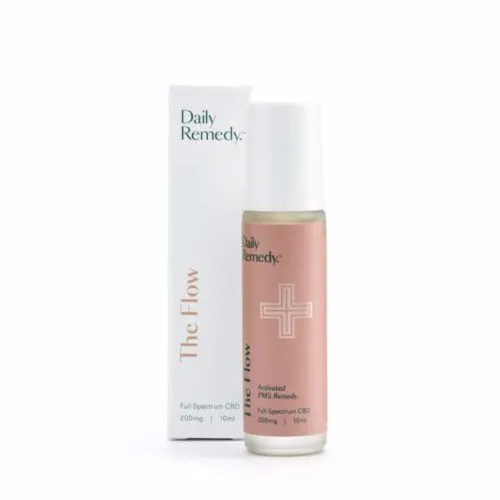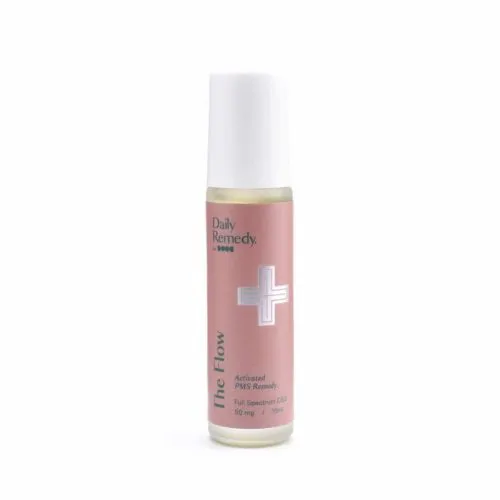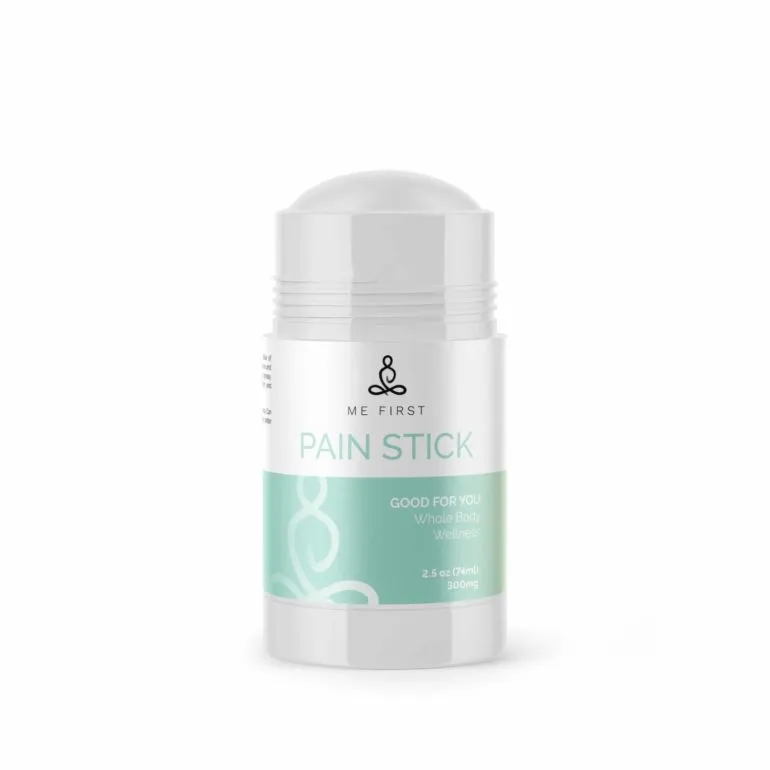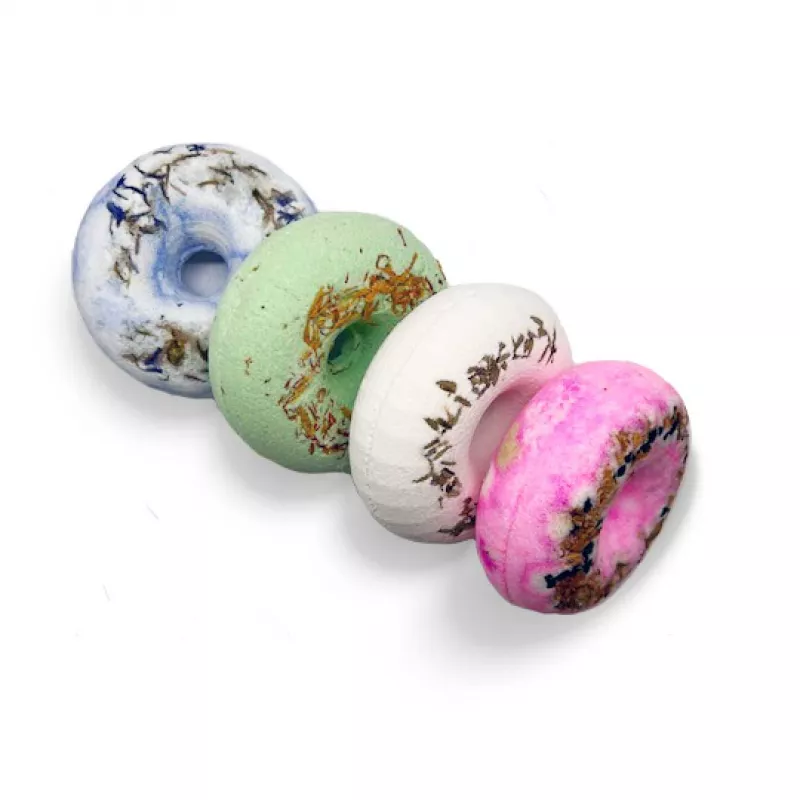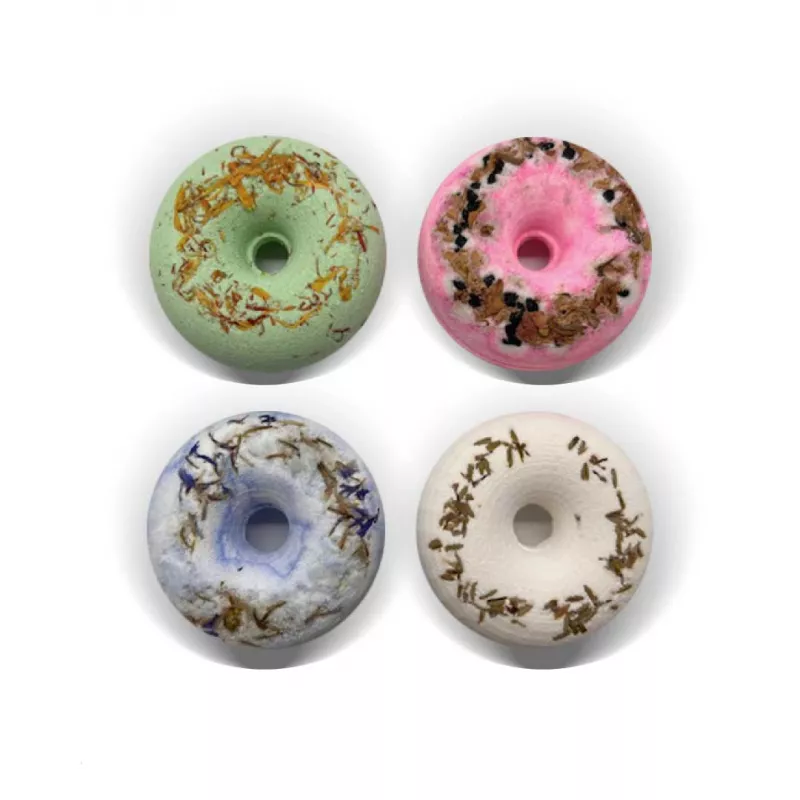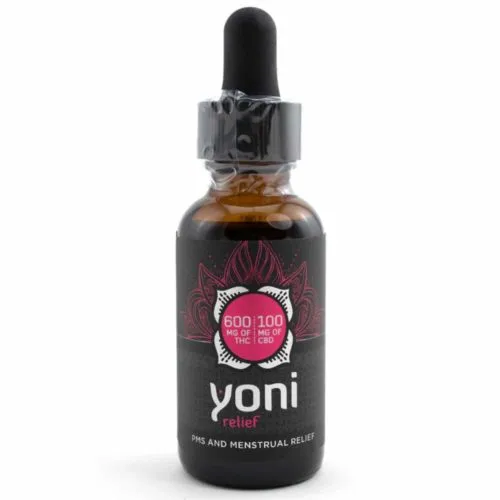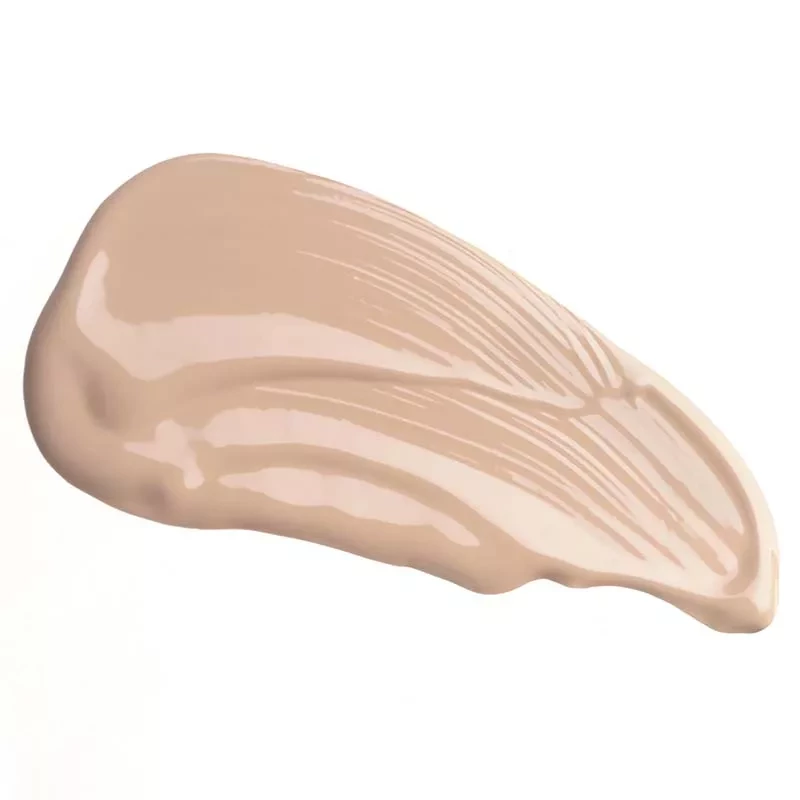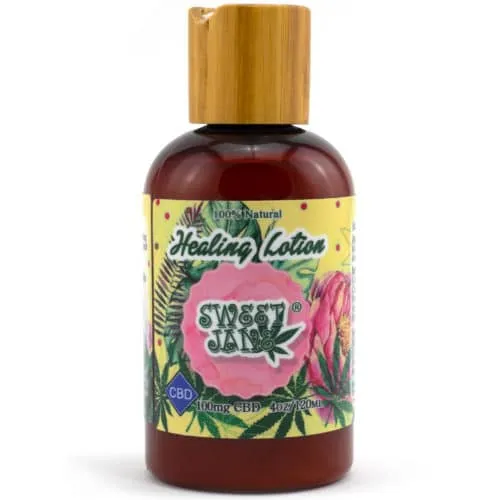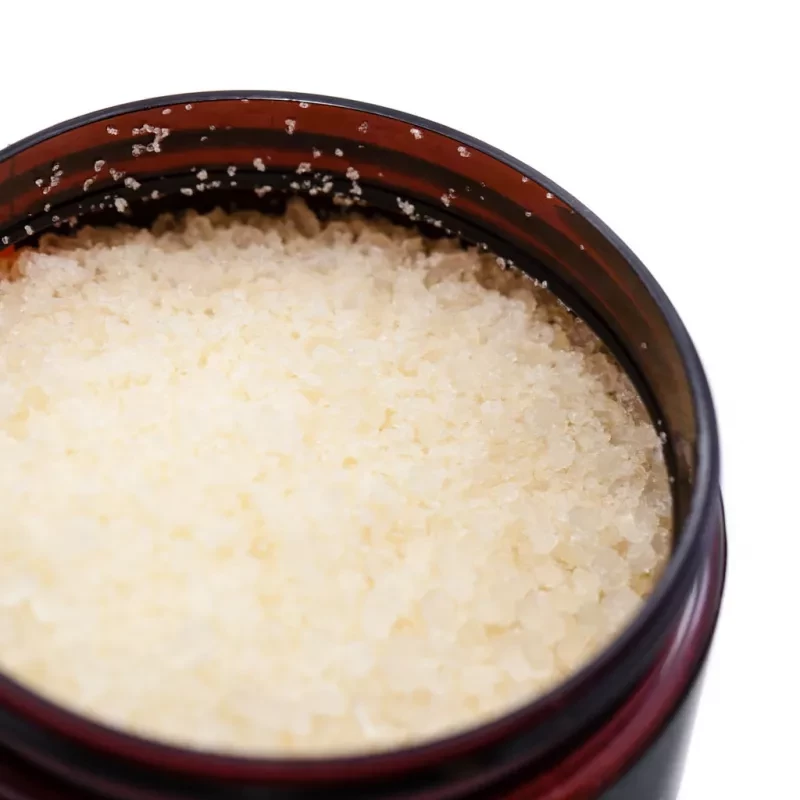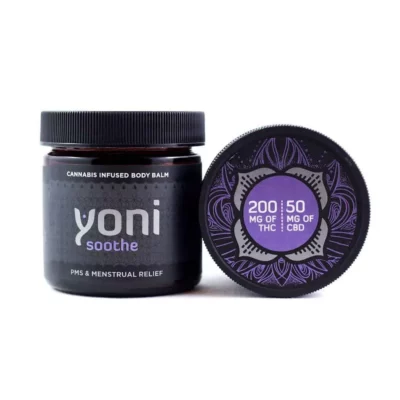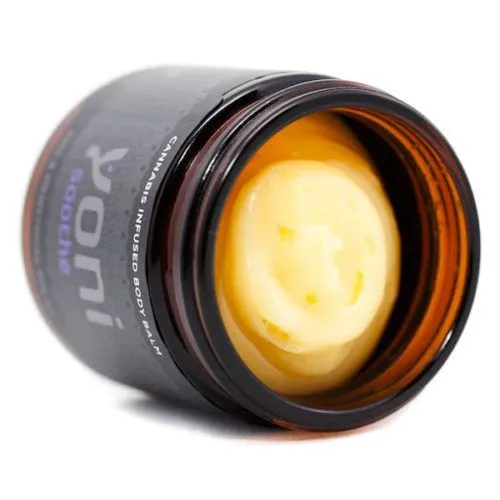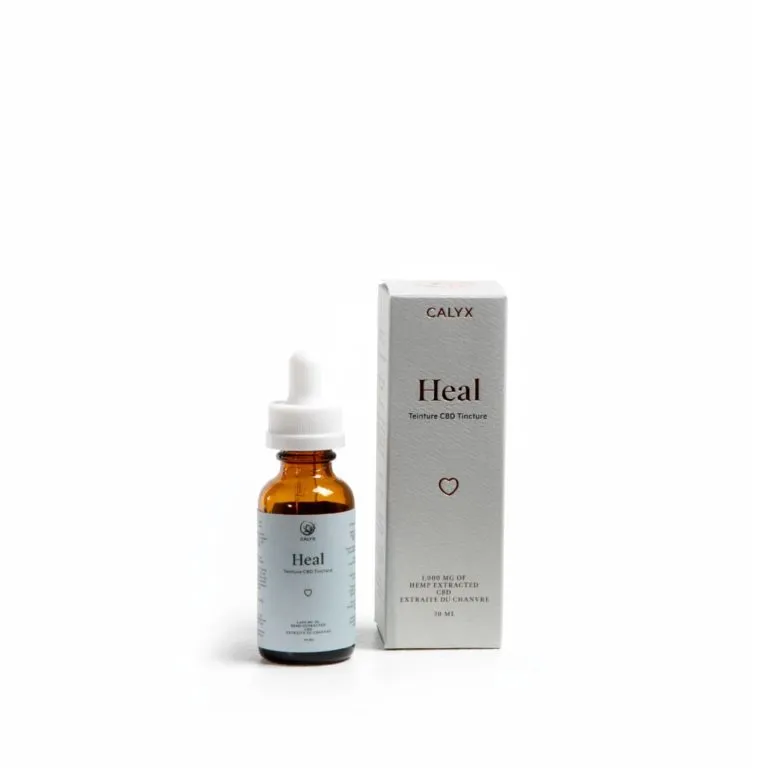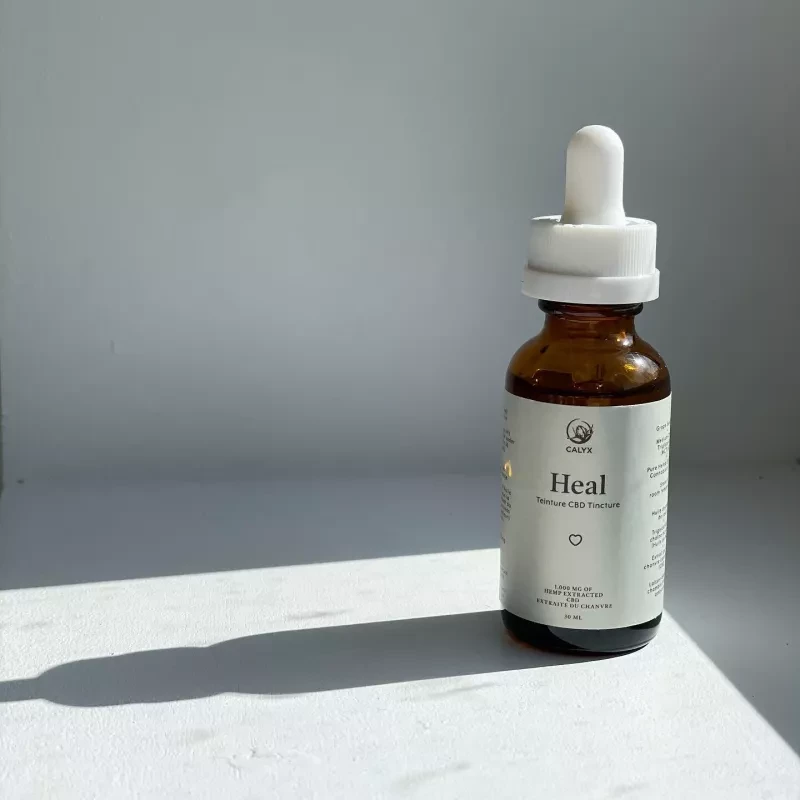Rick Simpson Oil: A Comprehensive Guide Rick Simpson Oil Cancer Rick Simpson Oil (RSO) has become a popular alternative treatment among cancer patients. RSO is a concentrated cannabis extract typically […]
- Shop All
- Type
- (144) THC>
- (75) CBD>
- Need
- Sleep>
- (21) Pain>
- (10) Anxiety>
- (6) Pets>
- (88) Edibles
- (14) CBD Edibles>
- (60) THC Edibles>
- (3) Ratio Edibles>
- (33) Hybrid Edibles>
- (87) Vegan>
- (5) Beverages>
- Strain
- (29) Indica>
- (24) Sativa>
- (47) Hybrid>
- (14) Tinctures
- (5) Anxiety Tinctures>
- (9) CBD Tincture>
- (1) Pain Tincture>
- (4) Ratio Tincture>
- (4) Sleep Tincture>
- (4) THC Tincture>
- (4) Capsules
- (1) CBD Capsules>
- (0) THC Capsules>
- (3) Ratio Capsules>
- Foggers
Shop for Pain Relief
-
Cooling 1:1 Transdermal Pain Relief Cream - Birch + Fog
THC 250mg | CBD 250mg$75.00 -
Warming 1:1 Transdermal Pain Relief Cream - Birch + Fog
THC 250mg | CBD 250mg$75.00 -
Peppermint 1:1 Pain Relief Stick - Birch + Fog
THC 125mg | CBD 125mg$44.95 -
Spicy Mint 1:1 Pain Relief Stick - Birch + Fog
THC 125mg | CBD 125mg$44.95 -
CBD : CBN Capsules 1:1 Ratio - Now + Then
THC 0mg | CBD 900mg$65.00 -
Honey Oil Glass Dispenser - Now + Then
THC 1000mg | CBD 0mg$30.00 -
Indica Extract Glass Dispenser - Now + Then
THC 1000mg | CBD 0mg$28.00 -
Phoenix Tears Glass Dispenser - Now + Then
THC 1000mg | CBD 0mg$26.00 -
Alleviate Cbd Vape Cartridge - Cannalier
THC 0mg | CBD 500mg$32.00 -
Joint & Muscle Pain Cbd Roller - Daily Remedy
THC 0mg | CBD 200mg$24.00 -
Mini Cbd Pain Stick - Me First
THC 0mg | CBD 120mg$22.50 -
Pms Relief Cbd Roller - Daily Remedy
THC 0mg | CBD 200mg$24.00 -
DEAL
Headache Relief Cbd Roller - Me First
THC 0mg | CBD 200mg$35.95$28.76 -
Cbd Pain Stick - Me First
THC 0mg | CBD 300mg$45.99 -
DEAL
Cbd Bath Bombs (4 Pack) - Ritual
THC 0mg | CBD 75mg$39.17 -
Pms Relief Tincture - Yoni
THC 600mg | CBD 0mg$36.99 -
Soothing Thc Lotion - Sweet Jane
THC 1300mg | CBD 0mg$20.99 -
Healing Cbd Lotion - Sweet Jane
THC 0mg | CBD 100mg$20.00 -
Pms Relief Bath Soak - Yoni
THC 300mg | CBD 0mg$25.00 -
Soothe Pms Relief Balm - Yoni
THC 200mg | CBD 0mg$40.00 -
Heal Cbd Tincture - Calyx
THC 0mg | CBD 1000mg$79.95
New to CBD?
Benefits of CBD
Types of CBD
Forms of CBD
CBD Dosage
CBD Instructions
CBD & Pets
New to CBD?CBD Pain TipsShop Pain ReliefPain TypesForms of Pain ReliefCBD Pain DosagePain TreatmentCBD Pain FAQTop 5 Types of Pain CBD is Used to Treat
5 Chronic Pain
In chronic or persistent pain, pain that lasts longer than 12 weeks despite medication or treatment is considered chronic or persistent. The majority of people are able to return to their previous level of functioning following an injury or surgery. However, occasionally the pain lasts for a longer period of time or appears without any previous history of injury or operation. CBD for chronic pain is best used on a daily basis with long acting delivery mechanisms such as capsules, tinctures and edibles.
Chronic pain can manifest itself in a variety of ways, the most common of which is regular headaches. Pain caused by nerve injury. back discomfort in the lower back.
In order to effectively manage chronic pain, consider employing the following measures, which have been shown through time and when used regularly and together:
Stretching, practising excellent posture, and moving softly are all recommended.
Continue to be active whenever possible
Practice relaxation techniques, such as taking a CBD bath, to aid in reducing stress.
Make sure to take it easy. Do not push yourself to the limits and try to avoid further injury and strain.
Take care of any other issues that are causing you pain. Consult with a physician to determine a path to less pain. There are a variety of types of CBD, both topicals and edibles for example, that may help you in this process of recovery.
4 Neuropathic pain
It is believed that nerve injury or other damage to other sections of the nervous system is responsible for neuropathic pain. It is frequently described as a shooting, stabbing, or scorching pain, or as pins and needles sensation when it occurs. It can also impair a person's sensitivity to touch, causing them to have difficulties distinguishing between hot and cold feelings. Enter fast acting topical CBD and long acting daily use CBD.
Neuropathic pain is a type of persistent pain that affects many people. It can be intermittent (meaning that it comes and goes), and it can be severe enough that it makes doing routine tasks difficult or impossible. The fact that the discomfort might interfere with normal movement means that it can also result in mobility problems.
There is some hope that CBD can alleviate the discomfort associated with neuropathy. Furthermore, because CBD has relatively minor side effects, utilising CBD to assist alleviate this type of pain may be an acceptable option to other potential pain medications, such as highly addictive opioids, that are currently available, and by some, considered to be over-prescribed.
Postherpetic (or post-shingles) neuralgia, reflex sympathetic dystrophy / causalgia (nerve trauma), components of cancer pain, phantom limb pain, entrapment neuropathy (e.g., carpal tunnel syndrome), and peripheral neuropathy are examples of such conditions (widespread nerve damage). Speak with your doctor to determine whether CBD may be effective in treating your neuropathic pain.
3 Radicular Pain
Radicular pain is a highly specific sort of pain that occurs when a spinal nerve is crushed or irritated, and it can be extremely painful. It travels down the spine and down the hip into the leg(s) by way of the spinal nerve root and into the leg(s). People who suffer from radicular pain may endure tingling, numbness, and muscle weakness as a result of their condition.
Radiculopathy is a term used to describe pain that radiates from the back and into the leg. Pain in the lower back and legs is frequently referred to as sciatica since it is caused by an injury to the sciatic nerve. This type of discomfort is usually constant, and patients might feel it all the way down their leg. Walking, sitting, and a variety of other activities might exacerbate sciatica symptoms. As one of the most prevalent types of radicular pain, it is also one of the most severe.
Globally speaking, more high-quality human research is needed to determine whether cannabis-derived CBD and hemp-derived CBD are safe and effective treatment choices for radicular pain. Evidence, on the other hand, is mounting indicating CBD and hemp may have a significant role to play in the management of chronic spine pain and the reduction of opioid-related dangers associated with pain management.
CBD has been shown to lessen nerve-related and inflammatory pain in animals, suggesting that it has a promising future as an everyday pain management option, according to a study published in 2018. The fact that CBD is a safe and effective addiction therapy has also contributed to the surge in popularity of CBD for its potential to cure opiate addiction and prevent it from becoming a viable chronic pain-relieving alternative.
2 Nociceptive Pain
Nociceptive pain is a medical word that refers to the discomfort caused by physical injury or the threat of physical injury to the body. Pain experienced as a result of a sports injury, a dental surgery, or arthritis are all examples of this. CBD is effective for nociceptive pain when used daily as a preventative, for example pre-surgery, and as a fast acting remedy through vaping or topical applications.
It is nociceptive pain that is the most commonly encountered sort of pain by people. Nociceptive neuropathy arises when the nociceptive nerve fibres in the body are stimulated by an inflammatory response, drugs, or physical events such as stumbling over a piece of furniture.
Nociceptive pain is a type of pain that is generated by tissue injury in the body. It is frequently described as a sharp, achy, or throbbing pain by those who have experienced it. It is frequently brought on by an external injury. For example, if you stub your toe, twist your ankle, or fall and scrape up your knee, you may experience nociceptive pain in that area. Joint pain, muscle pain, skin pain, tendon pain, and bone pain are all common sources of this type of discomfort. It can manifest itself as either acute or chronic.
There are many different methods to utilise cannabidiol (CBD), but if you're searching for pain relief or aid with skin disorders, a topical CBD product may be your best option. CBD is a cannabinoid found in marijuana. A CBD topical is a cream, lotion, or salve that has been infused with CBD and can be applied directly to the skin to provide relief from pain.
1 Acute Pain
Acute pain is defined as pain that lasts for a brief period of time (roughly speaking), ranging from a few minutes to around three months (sometimes up to six months). Acute pain is often associated with a soft-tissue injury or a short disease, and as a result, it usually fades once the injury or illness has healed or when the condition has passed. Acute pain caused by an injury may progress to chronic pain if the injury does not heal properly or if the pain signals are not properly processed.
Acute pain is typically characterised by sudden onset and is induced by a specific event. It has a high level of sharpness. Acute pain is usually only present for a period of six months or less. When there is no longer an underlying cause for the pain, it will go away completely.
Acute pain is defined as pain that occurs suddenly as a result of an injury — such as a cut, bruise, burn, broken bone, or torn muscle, to name a few examples. Pain that occurs suddenly and unexpectedly can be caused by a fever or infection, labour contractions, or menstruation cramps.
Fast acting CBD products such as a CBD vape pen, CBD nano emulsions, CBD sublingual sprays and CBD topicals are the most suitable options for treating acute pain. In the cases of menstrual cramps for example, combining daily use CBD capsules with as-needed, fast-acting topicals will provide maximized relief both over time and in the minutes following application respectively.Top 5 Considerations Shopping CBD for Pain ReliefIt has been shown that cannabis has been used to relieve pain as long back as 2900 B.C.
Researchers have determined that some components of this sacred plant, particularly cannabidiol (CBD), are responsible for the pain-relieving benefits, in more recent years.
The endocannabinoid system (ECS) is a specialized system found in the human body that is involved in the regulation of a number of processes such as sleep, appetite, pain, and immune system response. The body creates endocannabinoids, which are neurotransmitters that attach to cannabinoid receptors in the neurological system, which are found throughout the body.
A number of studies have demonstrated that CBD may be effective in the treatment of chronic pain by influencing endocannabinoid receptor function, decreasing inflammation, and interacting with neurotransmitters. Some studies have shown that CBD injections can diminish the pain response to surgical incisions. Another rat study discovered that oral CBD medication can lower sciatic nerve pain and inflammation.
According to the findings of several human studies, a combination of CBD and THC is useful in the treatment of pain associated with multiple sclerosis and arthritis. The use of an oral spray containing a mixture of THC and CBD, known as Sativex, to alleviate pain associated with multiple sclerosis has been licensed in various countries.
One research of 47 persons with multiple sclerosis looked at the effects of using Sativex for a month and found that it was beneficial. Pain, walking, and muscle spasms were all reduced in the study subjects as a result of the intervention. Although the study did not include a control group, it is possible that placebo effects were present as well.
According to a study published in the European Journal of Pain, CBD administered topically to the skin could help reduce pain and inflammation associated with arthritis in an animal model. Moreover, another study established the method by which CBD reduces both inflammation and neuropathic pain, two of the most challenging types of chronic pain to treat.
Animal studies have demonstrated that CBD has anti-inflammatory properties and that it acts on the endocannabinoid and pain-sensing systems to alleviate discomfort. Unfortunately, just a few human trials studying the use of CBD as a single agent to reduce pain have been conducted, with the majority of these studies examining the use of a combination of CBD and THC to alleviate pain.
Health Canada has approved a combination drug that contains both THC and CBD in a 1:1 ratio for the management of central nerve-related pain in multiple sclerosis and cancer pain that has not responded to optimal opioid therapy, among other uses.
An observational research of CBD treatment found that people with non-cancer-related pain reported an improvement in self-reported quality of life measures, but that there was no statistically significant improvement in those with cancer-related pain or neurological symptoms.
The list of benefits of using CBD for pain continues to grow, seemingly by the minute. Always consult with your doctor to determine whether CBD is a suitable treatment method for you. Once you have come to a decision on this, there are several things to keep in mind when on the hunt for CBD products to add into your toolbox for pain management.
The top 5 things to consider when shopping for CBD for pain
5 Decide why you want to use CBD and what type of CBD you want it to take.
Of course, the first thing to think about is why you want to take CBD in the first place. Identifying the source and frequency of your pain is crucial to determining the best pain management program. Despite the fact that CBD is being touted for numerous potential health benefits — and some preliminary research suggests that it may be beneficial for everything from pain and anxiety to multiple sclerosis and opioid addiction — it has only been ‘proven’ to be effective in treating two rare but devastating forms of epilepsy at this time.
In addition, little in the grand scheme of things, is known about the many forms and types of CBD that might be beneficial for different situations (such as pills, topicals, or drops). Industry experts, medical professionals, and users alike, on the other hand, have some recommendations of CBD products that show promise in the treatment of pain.
Inhaling CBD, whether through a disposable or refillable vape pen (think e-cigarette) or a cigarette-style device, may be the most efficient method for providing very immediate relief from, for example, muscle cramps or anxiety. Oil drops under the tongue may be effective for achieving benefits in a short period of time.
Topical lotions, which are applied topically to the skin, have varying effects from person to person; some people feel the effects immediately, while others may not feel them for several hours. CBD in food products, on the other hand, is likely to take longer to be absorbed into your system, possibly as long as 30 minutes or more. Do you need something fast acting for acute pain such as muscle tension or period pains, or are you aiming to treat chronic pain on a longer term basis?
4 Take into account how much, if any, THC the product contains.
For the most part, this is vital if you want to avoid the psychoactive high associated with THC, which is something that many individuals who are considering CBD value intrinsically. However, understanding the THC content of a product can be useful for a variety of other reasons, including determining how effective a product is and where it can or should be purchased.
A small amount of THC appears to be beneficial in some people, according to Project CBD, an advocacy group that supports CBD research. Understanding the benefits of "entourage effect," which refers to the concept that the sum of two chemicals, as well as other associated compounds in the plant, is greater than the sum of their individual parts may help you to decide whether to use a full-spectrum CBD vs a broad spectrum CBD or CBD isolate.
It is also possible that only a little quantity of THC is required to boost CBD's therapeutic effect, such as the 0.3 percent (0.3%) threshold required for CBD products derived from hemp.
So, if you're looking for a product that has a small amount of THC but not enough to get you high, go for one that is manufactured from hemp. Such products have the additional advantage of being widely available, including both online and in brick-and-mortar retail establishments. Experts believe that CBD products should list any THC levels on their labels. In order to be sure of what you are consuming, read the ingredient list carefully, the guidelines for consumption and product COA (certificates of analysis) if available.
It may be more of a search to locate a CBD product that contains more than 0.3 percent THC or products such as 1:1 or 3:1 THC:CBD, but indeed they are available.
Dispensaries may sell a variety of “CBD-rich” items that are high in CBD and low in THC, such as oils, tinctures, topicals, and vape liquids, as well as other cannabis-related products. The authors of "Cannabis Pharmacy: The Practical Guide to Medical Marijuana" believe they may even sell buds or flowers from strains that have been engineered to contain very low levels of THC. Speak with representatives through your online or local dispensaries for recommendations. .
For those who are considerably more sensitive to the psychoactive effects of THC than others, the THC levels in your CBD products should certainly be taken into consideration. As a result, if you want to avoid the psychoactive effects of CBD, it's best to stick with CBD derived from hemp, or CBD in broad-spectrum or isolate form.
3 Research the brand or manufacturer of the CBD products you are considering to purchase
Find out some basic details on the manufacturing processes or ingredient qualities of the brands of CBD products should you intend on consuming any of them for pain management. We have taken a lot of the headache out of this process, and offer you carefully curated brands to ensure that you are purchasing top quality, leading products when purchasing through our site.
Many CBD products marketed online and in retail stores are derived from hemp, not marijuana, according to their manufacturers. Furthermore, the origin and strain of the hemp can be significant.
According to Colleen Lanier, executive director of the Hemp Industry Association, the majority of hemp used in CBD products sold in the United States comes from Colorado or Oregon (which have long histories with cannabis) or Kentucky (which passed a law to support hemp growers in 2013), or it is imported from other parts of the world, in countries where cannabis is decriminalized or legalized.
Colorado, according to Lanier, is the state with the most developed hemp program out of all of them. As a result of complaints, the state's agriculture program conducts spot tests on hemp plants while they are still in the field to determine their THC content, and it will investigate the possibility of the use of prohibited pesticides in the field. In addition, the US 2018 Farm Bill may make it easier for farmers to produce hemp while also increasing the number of states where it is grown and tested.
Research products created from hemp cultivated overseas or in countries other than your own, where quality and legal standards may vary from those in your local community. Such products can be much more troublesome because they may not be subjected to any provincial, state or federal testing, which may mean they are less regulated or monitored. Wherever possible, it may be worth you seeking access to related testing results. Producers should adhere to local governing guidelines for good manufacturing procedures.
When purchasing CBD products derived from hemp, check the labels to discover where the hemp was produced. That information, however, is not included in every product. To find out where the hemp was grown, inquire with the staff when visiting a dispensary or retail establishment. In addition, for CBD products acquired online, check the company's website to see if the information is available, or contact the seller directly to ask the same query.
2 Read through test results or COAs when available
Consider requesting to view the COA, or certificate of analysis, for any product you are considering purchasing. A product's performance on testing for CBD and THC concentrations, as well as the presence of contaminants, is likely documented in this document.
Certification of origin for such items comes from tests that the corporation or manufacturer represented by a specific brand, has often arranged on its own. Some dispensaries may provide this information to their clients at the point of purchase. Despite the fact that not all manufacturers take this step, many do. This includes even those businesses that rely on imported hemp, such as CV Sciences, which manufactures CBD Oil from hemp cultivated in the Netherlands, but for distribution to clients in the United States.
The product and the merchant should be avoided if the information is not available from an online manufacturer or a retail store or if you discover a reluctance in sharing, or a lack of transparency when trying to obtain this information.
Some North American provinces and states, including Indiana, have made it easier for consumers to locate these certificates of authenticity. To exemplify, and hopefully in the efforts of establishing an industry wide standard, hemp-derived CBD products sold in Indiana stores must now contain a QR code on their label that allows customers to readily download the product's Certificate of Authenticity (COA) to their phone. It is important for consumers to understand what is in their product and what they are ingesting.
The COA will help to provide even more assurance regarding the product's quality. This shows that the laboratory maintains high scientific standards. Look for testing procedures that have been verified by a recognised standard-setting organization such as the Association of Official Agricultural Chemists (AOAC), the American Herbal Pharmacopoeia (AHP), or the United States Pharmacopeia (USP), in the United States. Other nations have established similar standard-setting organizations.
Unlike CBD products generated from hemp, those derived from marijuana must be tested before being sold, at least in places where marijuana is legal for medical and recreational purposes. COAs are expected to be available at dispensaries in some locations, and staff members should be willing to share them with you. Otherwise, go to a different dispensary or choose a different product. Purchase from established dispensaries with strong user ratings and a well-established, well- trusted reputation.
1 Look for CBD products that clearly state the amount of CBD they contain.
When purchasing CBD products for pain, search for products that indicate how much CBD (or cannabidiol) you get, not only in the entire container but also in each recommended dose. It is typically suggested to start with medications that have relatively modest dosages, because they are easier to administer. Dosages are expressed in milligrammes, or mgs, and can vary significantly depending on the type of the product.
Be especially cautious when purchasing CBD-containing products that merely state the total amount of “cannabinoids” they contain rather than the particular level, or form of CBD they contain. Not only may CBD and THC be among those cannabinoids, but so could a slew of other closely related chemicals. Companies may choose to label their products in this manner in the hopes of drawing less attention from the Food and Drug Administration or other governing bodies.
Some of those products, which do not list the quantity of CBD in their ingredients list, sell themselves as "whole plant" or "full spectrum" hemp products, or claim to be high in other compounds derived from the plant, such as different fatty acids, in order to attract more customers.
Although it is possible that those other molecules have additional health benefits, and that they may contribute to the ‘entourage effect’, it is yet to be fully confirmed whether they do or not, and many reports remain as anecdotal, and are as such not necessarily, scientifically proven. In certain circumstances, you could look at the certificate of authenticity (COA), if they have one, which should state how much CBD or THC is in the product.Top 4 Types of CBD for Pain Relief
A total of four primary types of CBD exist, three of which are well-known to the general public and the fourth of which is only recently making its way into the mainstream. Each one includes a unique combination of chemicals at varying amounts.
Cannabidiol (CBD) is a chemical component found in the cannabis plant that has been shown to have numerous therapeutic advantages. CBD, in contrast to delta-9-tetrahydrocannabinol (THC), does not produce a euphoric high after ingestion, indicating that it is non-psychoactive.
Companies that manufacture CBD products use a number of extraction processes to remove the active ingredient from the plant, depending on the product being manufactured. Numerous forms of CBD are formed as a result of the various diffusions that have occurred.
In spite of the fact that CBD in its many types has much more benefits than hazards, the possibility of getting a criminal record or even being imprisoned should be avoided to the greatest extent possible, even if it means forgoing the use of this miraculous compound for the time being. Be sure to familiarize yourself, and follow any local restrictions or laws on consumption and possession.
As previously reported, a large number of CBD products make inaccurate or misleading claims about the benefits of their own products. It is important for people to exercise caution and conduct research before purchasing any form of CBD. The Food and Drug Administration (FDA) is responsible for evaluating health claims and safety concerns.
We have selected a wide range of CBD products, in available types from full-spectrum CBD, broad-spectrum CBD, CBD isolate to nano CBD, in the efforts of offering you only premium brands and delivery mechanisms, and thereby taking some of the headache of doing the otherwise, time-consuming research on your own.
Products that have undergone independent testing should be sought after by consumers. Some supplement makers provide customers with a Certificate of Analysis (COA), which lists the substances contained in the supplement. Browse online MOM sites or brick-and-mortar dispensaries that have received excellent ratings and positive customer and product reviews before making your CBD product buy.
In this section we will explore the top types of CBD on the market today, each with their own set of characteristics best suited for one application over another. When it comes to CBD for pain, there are four main types available, and understanding the differences between them can be helpful in determining which one is best for you in managing your pain.
Our site contains a large number of thoroughly chosen variations of each type available in several different forms, from gummies, to tinctures to beverages. In your research, you may have come across phrases such as full-spectrum CBD, broad-spectrum CBD, CBD isolate, and even nano CBD, in the context of anti-cancer medication. Despite the fact that these types sound similar, they do in fact vary significantly.
The top four (4) types of CBD for pain
4 Full Spectrum CBD for pain
While the term ‘full spectrum’ may be confusing, it merely refers to the fact that the extraction process recovers all of the more than 113 cannabinoids found in cannabis. Full spectrum oils have what is known as the "entourage effect," which means that the overall effect is greater than the sum of the individual effects. In recent research, it has been discovered that using the entire plant, rather than just the CBD or THC, can increase the medical benefits of marijuana.
Cannabis oil, or CBD extract, contains a number of different components, including cannabinoids such as cannabinol. When it comes to full-spectrum CBD products, tetrahydrocannabinol (THC), the cannabinoid found in the cannabis plant that causes people to feel "high," may be present up to 0.3 percent.
THC is present in the end product due to the fact that this cannabis oil is made employing all of the cannabinoids. When it comes to producing psychoactive effects such as a feeling of being high, it is not nearly enough, and this is likely to be felt only by those who are extremely sensitive to THC in the first place.
Full spectrum CBD and CBD:THC ratio products are most commonly used in the long term treatment of chronic pain. Our assortment of full-spectrum extracts contain natural cannabinoids, which can help to reduce chronic pain, persistent neuropathic pain, and when used a preventative, can also contribute to a reduced pain response time in moments of acute or nociceptive pain, similarly to how arnica can act as an anti-inflammatory when ingested regularly and in the days or weeks leading up to surgery.
Daily use Full spectrum CBD is effective in reducing inflammation, increasing relaxation, and maintaining a healthy stress response. In a variety of potencies and formulations, full spectrum CBD is commonly sold as capsules, tinctures, gummies and chocolates. The Birch + Fog Day and Nighttime collections offer you a ride range of full spectrum CBD pain management solutions. Also consider exploring the Now + Then RSO Phoenix Tears or high one of our THC:CBD ratio formulas for any heavier hitting pain.
3 Broad - Spectrum CBD for pain
Broad-spectrum CBD is made up of a variety of naturally occurring substances derived from the cannabis plant, however it does not include any tetrahydrocannabinol (THC). Broad-spectrum CBD products, in addition to cannabichromene (CBC) and cannabinol (CBN), contain terpenes such as myrcene, limonene, and pinene, which are all found in the cannabis plant.
Broad-spectrum CBD is supposed to contain little if anyTHC. Some products, on the other hand, will contain trace amounts of the substance. There are a number of different methods for extracting CBD from the cannabis plant including steam distillation and solvent based extraction. The composition of CBD may be affected by the strain of cannabis plant used, its classification, and the method used to extract it.
Broad-spectrum CBD is a hybrid of full-spectrum CBD and CBD isolate that sits somewhere in the middle. In contrast to CBD isolate, which contains solely pure CBD, broad-spectrum products may have more potent effects due to the presence of additional components that function in concert with one another, a phenomenon referred to as the ‘entourage effect’.
Although there have been some recent studies on the so-called "entourage effect," there has been little specific research into the distinct forms of CBD or which varieties may be most beneficial for a given health problem, and many argue that for pain specifically, that a full spectrum of a high ratio THC:CBD product may be most efficacious.
The Natuur Pain Sticks and the Cloud9 Headache rollers are superior products for higher ratio, fast acting acute pain relief through topical application. For chronic pain and neuropathic pain, and for a longer acting daily use solution, explore the Birch + Fog Daily use tinctures and capsules.
2 Nano CBD for pain
For the layperson, nanotechnology is the process of shrinking anything from its original size to ‘nanoscopic’ dimensions. It may appear to be simple, but it is actually a very scientific process that takes place at the molecular level. The use of nanotechnology would reduce the size of a single molecule of CBD (cannabidiol) significantly.
You may be questioning why it is necessary to go through this process since it is so time-consuming and difficult to understand. Because nanotechnology reduces the size of particles and breaks down complex substances, it is believed to be easier for it to enter the body through the bloodstream and reach the liver more quickly thereby offering maximum bioavailability.
The lipophilic properties of CBD make it a good candidate for breaking down or utilising nanotechnology in its production. In theory, molecules might be either hydrophilic or lipophilic depending on their structure. The term hydrophilic refers to the ability of particles to attach themselves to water-soluble compounds. While the other is an oil-based compound that is not soluble in water, the first is a water-soluble substance. CBD is naturally lipophilic, which means it attracts fat.
Because human bodies are composed of 70% water, it is possible that cannabidiol will have a difficult time absorbing it. Consider the scenario in which you pour oil into a glass of water and expect them to mix well. It takes time for the body to absorb the cannabidiol material that has been introduced into it.
CBD in general is lipophilic, meaning that it repels water molecules that attempt to attach themselves to it. So, how will CBD oil be absorbed by the body? To solve this problem, nanotechnology is used.
When the cannabis is broken down into nanoparticles, it interacts with water molecules in a different way. About the real relationships between these molecules, there is a more scientific explanation available. While this may seem counterintuitive, the truth remains that by breaking CBD down to nanoparticle size, it may more easily attach and form bonds with lipids and water molecules.
This makes it possible for cannabinoids to be absorbed more quickly and easily. These nanoparticles have a significant impact on the amount of CBD that is available in the body.
This technology is proving to be highly relevant in the development of CBD nana-emulsions and CBD nano-beverages. What a soothing, refreshing way to consume your CBD for pain- in a delicious green tea or ginger ale Now + Then CBD nano beverage.
1 CBD isolate for pain
In contrast to hemp oil, CBD isolate is free of all impurities and toxins. Additionally, it does not include any other components of the cannabis plant in it. It is mostly generated from hemp plants, which contain relatively low quantities of THC. CBD isolate is less commonly used for long term management than it’s full spectrum counterparts, and when it is used daily for pain, it is recommended to consume it in the evenings before bed, limiting any chances of feeling groggy or a residual ‘high’ the next morning.
A variety of processes are used to extract all of the compounds and other constituents from the cannabis plant, including THC. CBD isolate is the result of this extraction process. Pure CBD in the form of crystals is obtained by this process.
CBD isolate is a crystalline solid or powder that is fully composed of the cannabinoid CBD. Full-spectrum CBD products, on the other hand, are permitted to include up to 0.3 percent THC under federal law. Despite the fact that this amount may appear on a drug test, it will not result in a noticeable high. However, for individuals who are new to cannabis products in general, starting with a CBD isolate will ensure that you will not experience any psychoactive side effects at all.
Because of the nature of the extraction processes that CBD isolate oils go through, they do not reap the benefits of the entourage effect. This is true with CBD isolate, which may be found as candies, tinctures, and vape cartridges, among other forms. CBD isolation does not have a distinct odour or flavour, whereas CBD vape oils do, and you may choose from a variety of flavours, with one that is sure to appeal to you.Top Forms of CBD for Pain ReliefWhen it comes to CBD for pain, there are numerous different forms available, and understanding the differences between them can be helpful in determining which one is best for which type of pain. Our site contains a large number of thoughtfully chosen variations of each form, selected to address chronic pain, acute pain, neuropathic pain, nociceptive pain and radicular pain. Consult with your physician and a dispensary representative to determine which form of CBD may be best for you.
In your research on available products and brands, you may have come across phrases such as full-spectrum, broad-spectrum, isolate, and even nano in the context of anti-cancer remedial pain medication. Despite the fact that these categories or types of CBD may sound similar, they do have different healing qualities for targeting specific pains, and they are all available in a variety of types/ delivery mechanisms.
What can CBD (also known as cannabidiol) do to help you manage your pain? It is unlikely that you will high on this naturally occurring cannabinoid, particularly if you opt for a CBD isolate, which does not not produce the same psychotropic effects as its cannabinoid sibling, tetrahydrocannabinol (THC).
Many people are discovering that it can be an effective addition to their pain management regimen. In fact, according to research, the vast majority of people who take CBD for a medical condition do so to address chronic pain, arthritis, and joint pain, as well as anxiety and stress.
CBD has been demonstrated to be beneficial in treating pain as it is anti-inflammatory, which means it has the potential to reduce joint pain associated with arthritis; it is anti-oxidative, which means it may reduce systematic inflammation by combating oxidative stress and decrease symptoms of autoimmune conditions such as lupus; and it is anti-emetic, which means it has the potential to reduce nausea and vomiting associated with cancer treatments.
CBD, in fact, has a wide range of impacts on the body's central and peripheral neurological systems, as well as the immune system, according to research. It works in concert with our endocannabinoid system to operate as an antioxidant, to reduce inflammation, and to act as an analgesic or pain reliever, among other things. Early model studies have suggested that CBD may even be able to delay the course of osteoarthritis and prevent nerve damage.
Furthermore, CBD has few adverse effects and a low-risk, zero-addiction profile, making it an excellent choice as a non-habit forming painkiller and for medical use. However, before you munch on a gummy, take a few drops of a tincture or apply a CBD topical to your achy bones, you should consider the following options for delivery.
The top 6 forms of CBD for pain
6 CBD Topicals for pain
People typically apply the CBD ointment, lotion or salve directly to the affected area and gently massage it in until it is fully absorbed. Users may experience sensations such as warmth, cold, or tingling depending on the product. Try out a Birch + Fog pain stick available in both heating and cooling options, for your topical CBD pain relief needs. CBD topicals are typically designed to be fast acting when applied dermally and directly to the source area of pain.
People should adhere to the instructions on the label and any packaging guidelines that may be present. It is also crucial to know that when CBD ointments are applied to open or injured skin, they may cause irritation.
The distinction between ointments and other topical products such as creams should also be understood by the general public. Typically, the most significant distinction is that ointments have the largest oil concentration, with an about 80 percent (*80%) oil content.
This implies that they remain on top of the skin and do not evaporate, allowing for the greatest absorption of the product. Read through the specific brand guidelines for use, as well as the ingredient list to ensure there are no additives that may cause a negative or allergic reaction.
5 Nano CBD Beverages for pain
Nanoemulsions of cannabis extract (nano-cannabinoids) have an unusually high bioavailability and therapeutic efficacy, and they are absorbed by the body very quickly and fully, making them a suitable choice for daily use management of chronic pain and for more sporadic fast acting applications such as when looking for pain relief from acute, neuropathic and nociceptive pain.
Because of the non-psychoactive qualities of CBD, the market is likely to see an increase in demand during the forecasted period of time. The lack of a euphoric impact in CBD beverages increases the potential for their use in medical applications.
Nano-CBD beverages have the potential to be employed in the treatment of pain in general, withdrawal from substance use, and diseases of the central nervous system. These aspects are predicted to increase the usage of the product, resulting in the expansion of the market segment in the long run. Sample the many flavours from the Now + Then line CBD beverages and start to feel your pan melt away.
4 CBD edibles for pain
CBD edibles such as gummies, chocolates, rice krispie treats and hard-candies are a superb, long acting form of CBD, highly beneficial in the treatment of both chronic pain and acute pain alike. As these forms of CBD must pass through the digestive system they do take longer to kick in, and are best used on a daily, long term basis, so that the medicine can take effect in your body, over time. Many users report up to six weeks of daily use before they notice significant reduction in chronic pain.
Pain signals are reduced with the use of CBD edibles. CBD controls pain and the sense of pain by promoting the reuptake of the neurotransmitter adenosine in the brain, consequently increasing adenosine levels in the brain and decreasing pain sensations. Additionally, CBD may prevent pain signals from reaching processing areas in the brain by binding to TPRV1, which is a protein that is involved in inflammation and pain.
The ability to control the immune response by decreasing levels of pro-inflammatory cytokines and inhibiting the proliferation of T cells has been demonstrated in patients with autoimmune and systemic inflammatory illnesses, among other conditions.
CBD edibles reduce inflammation. CBD acts as an antioxidant, which helps to reduce oxidative stress and systemic inflammation in the body. CBD may also help to reduce inflammation by preventing the loss of micronutrients such as zinc and selenium, which are important players in maintaining a healthy immune system.
CBD may also help to reduce neuropathic pain (such as fibromyalgia or neuropathic back pain) by preventing the occurrence of hyperalgesia (an abnormally heightened pain response). Sample the premium CBD edibles available on our site, such as the Mota gummies and chocolate bars, until you discover the perfect flavour profiles and delivery mechanisms for you.
3 CBD capsules for pain
Studies have shown that CBD capsules have bioavailability of about (13-16%). This number varies from report to report. Regardless of a firm number here, one of the other important discoveries is that CBD capsules are best used on a long term, daily basis when consumed with the purpose of treating any form of pain.
A lot of research has been done on osteoarthritis, a painful joint condition that has been linked to cannabidiol. Some preliminary research suggests that CBD operates as an antagonist, blocking or debilitating the GPR55 receptor, which may help to halt the progression of osteoarthritis by promoting bone resorption.
CBD has been shown to activate a receptor known as PPAR-gamma, which has the potential to improve insulin sensitivity, which is a critical step in treating type 2 diabetes and thus reducing the chance of developing diabetic neuropathic pain, among other benefits.
Liposomal inflammatory and autoimmune diseases, such as Lupus and Rheumatoid Arthritis, as well as fibromyalgia, are all being investigated with CBD, and the reports of a significant reduction in pain among daily, regular users fo CBD is promising.
There is conflicting evidence about the effectiveness of CBD (as well as THC) in reducing MS-related pain and spasms, with many anecdotes suggesting a lean towards CBD isolates over full-spectrum CBD.
CBD capsules by Birch + Fog, Natuur and Now + Then, have all made our list of top recommendations for daily use CBD capsules for pain management. Be sure to consult with your physician before commencing any new supplement or treatment program.
2 CBD tinctures for pain
It has been shown that CBD tinctures have an average sublingual bioavailability of up to 13 percent to 19 percent (13-19%) when administered sublingually (by placing drops beneath the tongue). Keep the CBD under your tongue for a few moments so that it may be absorbed by your sublingual gland, which then allows it to enter your bloodstream and begin working its benefits. The sublingual delivery of CBD, while not quite as quick as the inhalation approach, nonetheless generates effects rather quickly, within 20 minutes or so, making a CBD tincture a reasonable option to have on hand in the times of acute and nociceptive pain.
Of course, the key here is to keep the CBD in the proper location (beneath the tongue) for the appropriate amount of time to have the desired effect (30 to 60 seconds). If you swallow too rapidly, or if you apply the drops above your tongue and swallow quickly, you may as well be ingesting the CBD, which has a substantially lower bioavailability than ingesting the CBD topically as it must pass through your digestive system and liver.
1 CBD vapes for pain
As a result of CBD's versatility, it is also an excellent treatment for a variety of health problems, including chronic pain, acute pain, and inflammation; it is even effective in treating a wide range of neurological conditions, including Alzheimer's, Parkinson's, and multiple sclerosis.
If you're looking for immediate relief, CBD vaping may be the best option for your situation. It is more rapid in the absorption of CBD in vape oil than in other CBD products such as edibles and capsules. Due to the fact that CBD enters your circulation through your lungs rather than your digestive system, vaping is a good option for those with digestive issues and for those looking for fast acting pain relief.
The therapeutic benefits of CBD vape oil are typically felt immediately, or within a few minutes of inhaling the oil. Because of its rapid absorption rate, vape oil is a suitable alternative for persons who have acute pain, short-term tension, or pain flare-ups and neuropathic pain. Read through our section on CBD vapes to learn more on the advantages of CBD vaping.Top 4 Considerations with CBD Dose for Pain ReliefAs detailed in the pain and me section, and further in the benefits of CBD for pain section, there are several different ways to use CBD depending on what ailment or pain you are trying to address.
By now you may have read through articles on determining which form of CBD to use, perhaps you have developed a preference for one type of delivery mechanism over the next. If you haven’t already done so, read through those sections prior to determining a dosing schedule related to the product type and means of consumption.
Many CBD products come equipped with usage guidelines or recommended dosing. These recommendations will vary on whether the products are designed for daily use or for fast acting, periodic use, and they are influenced by factors such as your body weight, pre-existing conditions, even how rested, hydrated or full you are at the time of consumption. Always consult with a physician prior to adding a cannabis product into your supplementary or pain management program.
By just reading the package insert for any OTC pain reliever, it is easy to determine how much medication you should be taking to alleviate the symptoms you are experiencing. Finding the optimal cannabidiol (CBD) dosage for pain treatment, on the other hand, is not that straightforward.
CBD enthusiasts are enthralled by the substance's ability to alleviate pain, reduce inflammation, relieve anxiety, and promote sleep. However, there has been limited definitive research into just how much CBD a person needs to consume in order to get the advantages of the plant.
There have been very few human studies on CBD, and those that have been done have used a wide range of dosages: from 1 mg to 1500 mg. In some studies, patients were given 5 mg of CBD, while in others, they were given as much as 600 mg of CBD. To further complicate matters, CBD is available in a variety of types, including oils and tinctures, creams and lotions, tablets, vaping, and edibles, each of which has a different level of bioavailability than the others (the percent of active ingredient that gets into your bloodstream).
Keep in mind there are no standard amounts of CBD for pain management, for patients. At the end of the day, it comes down to trial and error, but it is important to go about it in a systematic manner., and to self- monitor the results.
Listed below are suggestions to assist you in determining the appropriate CBD dosage for your pain alleviation and other symptoms.
The top four (4) things to consider with CBD dosage for pain
4 Consult with your physician and an industry professional
There are a variety of factors that can influence how much CBD you require to treat your symptoms, including your body mass index (BMI), specific health condition(s), medications you are already taking, your medical history, and the form of CBD you intend to utilise. However, despite the fact that CBD is distinct from medicinal marijuana — which contains both CBD and THC, which is an intoxicating element — a doctor who is well-versed in cannabis (marijuana) is likely to be the ideal person to assist you in sorting things out.
Starting a CBD treatment program without the guidance of a physician is not recommended. When people purchase a CBD product and test a dose that does not work for them, they switch products and continue to tinker around. Or, even worse, they have adverse effects. It is of course important to monitor the immediate and ongoing effects, to influence your decision on whether to increase or reduce the dose.
To find an expert, ask your primary care provider for a recommendation, or friends who have gone down this road of using CBD for pain management, or search for one in your area by consulting a representative at a reputable online or local dispensary.
Start slow and low. On days when you're experiencing a lot of discomfort, you can take upwards of 40 mg. Afterward, you increase the dosage in 15 mg increments each week, as tolerated. Do not exceed the recommended dose and be sure to monitor when you have achieved the desired effects and at what dose. You could be thinking that your pain is now manageable at this stage. When taking CBD, it's always a good idea to keep note of how much you're taking and whether or not your symptoms are getting better.
3 Do some basic calculations
Consider the following scenario: you and your doctor agree on a daily CBD dose of 30 milligrams. So, what do you do now? The answer is dependent on the form of CBD that you consume.
Simply reading the supplement facts section on the label of capsules or gummies will provide you with the amount of CBD contained in the product. (For example, if the capsule contains 10 mg of CBD, you would need to take three capsules to achieve your daily CBD need of 30 mg.)
With CBD oils and tinctures, it can be more difficult to determine the amount of CBD present in the entire bottle, rather than just in the dropper.
You'll most likely see the total amount of CBD in the container indicated on the label of CBD topical products (creams, lotions, and salves), if you're looking for that information. Once you've calculated the overall amount, you'll need to divide it by the number of millimetres in the package to find out how much is included in each millilitre. A 50 mL jar of salve with 200 mg of CBD in it, for example, contains 4 mg of CBD per mL of salve. After that, you should use a measuring spoon to scoop out 7.5 ml of CBD to acquire a 30 mg dose of the substance.
It is also important to determine the form of CBD - full spectrum, broad spectrum, isolate or nano, as these have various levels of bioavailability and are effective in different ways and for different ailments.
There are a full range of CBD products available on our site in each of the different forms listed above, and in our CBD forms for pain section, and also in several different delivery mechanisms should you be more vape friendly or gummy friendly.
2 Be prepared for a little trial and error
Every patient is different, and no two patients respond to CBD in the same manner. You and your doctor will very certainly need to alter the dose, either up or down, until you achieve the optimal balance of benefits without experiencing any side effects. ”A great deal of it is determined by your biochemistry and the manner in which your liver breaks down these chemicals.” In Dr. Patel's opinion, there are a wide range of issues that come into consideration.
Noteworthy findings published by the World Health Organization and obtained from a 2011 investigation are as follows:
CBD has an effect on tumour cells when administered in high dosages, but it has no effect on non-tumor cells.
According to the limited studies, there is no effect on embryonic development.
CBD has been found to trigger hormonal alterations, however the significance of these findings is unknown.
Unless exceptionally high doses of CBD are provided... There are no documented adverse effects on a wide variety of physiological and biochemical markers or on animal behaviour.
CBD may be related with medication interactions, albeit the exact nature of these interactions is not known
CBD is one of the few compounds that the World Health Organization (WHO) has determined to have no significant negative effects or danger of dependency.
This does not imply that "testing" a hazardous amount of CBD is a smart idea in this situation. It does, however, provide reassurance that CBD users can experiment with different amounts in order to discover one that is effective for their specific, individual need.
It may take some time to get it just right for you personally, so be patient with yourself. Many people do not see a difference in their symptoms after taking one or two CBD capsules. According to Bridget Seritt, co-founder of the Canna-Patient Resource Connection, a Colorado-based organisation dedicated to protecting patient rights and eradicating stigma against those who use cannabis as medicine, it can take up to eight weeks of regular use before feeling the effects of the drug's effects.
1 If you experience any side effects, lower the dose or discontinue consumption of CBD
As a caveat, there haven't been many studies conducted on CBD at lethal concentrations. Morally speaking, that would be difficult to defend in this situation. According to a 2011 study published in the journal Current Drug Safety, the "toxic" amount of CBD is around 20,000 mg of CBD consumed almost all at one time.
It's vital to remember that the recommended starting dose for most ailments, including for pain management, is anywhere between 5 and 20 mg per day in order to fully grasp this. While studies have been conducted on dosages of around 1500 mg per day, the majority of tinctures contain between 100 and 1500 mg each bottle, depending on the manufacturer.
That means that, depending on the concentration of CBD contained within the bottles, a person would need to consume anywhere from 13 to 200 complete bottles of CBD tincture all at once to reach the potentially toxic amount of 20,000 mg of CBD . That is a difficult stretch to contemplate and one we would strongly recommend against.
Put another way, when CBD is taken at acceptable dosages, or even at doses higher than suggested daily doses, the average CBD consumer need not be overly preoccupied with consuming too much. In contrast to other substances, the hazardous dose (20,000 mg of CBD) is not usually regarded to be lethal in most situations. Possibly - in the same study noted above in Current Drug Safety, deadly doses were attained in monkeys; however, it would be inappropriate to test this in people due to the ethical issues involved, and there is as of yet, no available data to confirm overdose from CBD, in any human studies.
According to the widespread view among medical specialists, including the World Health Organization, CBD is likely to produce excessive drowsiness, lethargy, upset stomach, nausea, and diarrhoea, among other unpleasant and confusing side effects, rather than death, even in extremely high dosages.
No two people respond to CBD in the same way, and this is true for every patient. The dose will almost definitely need to be adjusted, either up or down, until you attain the best balance of benefits without experiencing any adverse effects, which you and your doctor will determine together.
The biochemistry of your body, as well as the way in which your liver breaks down these compounds ( in the case of edibles), play a significant role in this. There is a wide range of potential issues that must be taken into account.
It may take some time to get everything just right, so be patient with yourself. When one or two CBD capsules are taken, many patients report no improvement in their symptoms. CBD capsules, such as the Natuur daily use capsules, or the Birch + Fog Daytime or Nighttime capsules for example, are frequently formulated at lower doses (15-50mg/ capsule) and are designed be consumed on a daily, long term basis, where it can take up to six weeks of consistent use before feeling the effects of the CBD.
The bottom line is that CBD is relatively safe, even when used in seemingly high dosages. Like everything else, if consumed carelessly, it may have unpleasant side effects; however, these side effects have been shown to be somewhat insignificant when compared to those caused by other substances, including other cannabinoids such as THC. Here’s to a CBD-infused existence that is dose friendly, healthy and natural!Top 5 Ways to Use CBD for Pain ReliefIt has been increasingly popular to use cannabidiol, or CBD as it is more generally known, as a supplement in recent years. It shouldn't come as a surprise that CBD has gained widespread popularity in such a short period of time.
CBD is considered to be one of the safest and most therapeutically flexible medicines currently available on the market. Furthermore, unlike its brother tetrahydrocannabinol (THC), CBD does not cause a psychoactive high. In this brief guide, we'll go over not only how to best utilize CBD for pain relief, but we'll also cover some basic information about CBD itself.
To begin, what exactly is CBD oil? CBD oil, in its most basic definition, is a highly concentrated liquid whose principal active ingredient is cannabidiol (CBD). CBD oil is produced by extracting CBD from the cannabis plant and then infusing the oil with the extracted CBD. CBD oil is a type of dietary supplement. Carrier oils such as coconut and hemp seed oils are frequently utilized when producing CBD products such as capsules and edibles.
While the majority of research has focused on CBD as a compound, more researchers have recently begun investigating CBD oil and its potential effects on a variety of conditions, including chronic and acute pain, rheumatoid arthritis (RA), palliative cancer care, and multiple sclerosis, with preliminary results that have been promising so far.
One word of caution, however. CBD oil is not created equal. There are numerous low-quality CBD oils available for purchase on the internet or at your local dispensary. If possible, purchase CBD oil from a reputable dispensary such as here at Birch + Fog, where we offer only top quality CBD products manufactured by recognized producers, and where we openly share user reviews on the benefits of CBD for health and wellness.
CBD for pain is available in four primary forms : as detailed in our section on CBD for Pain- Forms. CBD oils are also available in a variety of types, also detailed in our section on CBD for Pain- Types. These include cartridges that allow users to vape CBD, such as the Vessel CBD vape system. We'll go through the different ways of consuming CBD and how to use it most effectively for pain treatment in the sections below.
The top 5 ways to use CBD for pain
5 Orally
You can use CBD oil flavor foods and beverages that you take orally, such as when adding it into a salad dressing. Depending on your weight, metabolism, and the food you've already eaten, your body will require a certain amount of time to digest the food you've consumed. There is a lower bioavailability when consuming CBD that must pass through your digestive system for absorption.
There is a range of time between 15 minutes and 2 hours for these types of CBD to take full effect. CBD oil for oral use is also available in capsule form, which you would take in the same way that you would take a multivitamin or other nutritional supplement. Simply swallow the gel-cap whole and wash it down with plenty of water. This method of consumption or delivery mechanism is well suited for long acting, daily use, and it is recommended to stick to a set time of day for ingesting, so that the dosing happens at regular intervals - much like taking a birth control pill at the same time each evening.
4 Sublingually
Putting CBD oil beneath the tongue is one of the most effective ways to get immediate relief from your symptoms. This method of consumption is great when fast acting pain relief is called for such as when you have sudden onset, periodic pain, or when you suffer from a minor injury, migraine or accident. These sprays are a must have for sufferers of radicular, nociceptive and neuropathic pain.
The active components are absorbed straight into the bloodstream, which can take anywhere from 5 to 15 minutes depending on the individual. With a sublingual bioavailability of 13 percent to 19 percent (13%-19%), CBD and/or CBD/THC ratio drops can be consumed quickly and easily, with users experiencing the therapeutic effects within approximately 20 minutes after ingesting them.
The fact that the digestive system must take time to break down the consumed material results in many substances losing their potential bioavailability and the time to onset of symptoms being prolonged. As such sublingual sprays are ideal to keep in your pain management tool box, even if you do not suffer from chronic pain.
Try out some of the Now + Then 4:1 drops, or the Calyx Heal drops, both available by delivery, and by simply adding to your cart. As mentioned in the dosing category earlier, you may need to do a little exploring when it comes to finding the perfect CBD product for you in your quest for optimal pain management.
3 Topically
CBD has been infused into lotions, salves and balms so that it can be used topically, applied straight to the regions of pain that are being experienced. By applying locally, you can alleviate pain and inflammation quite quickly, as well as treat stiff, achy joints, aching muscles among other things, without entering the bloodstream, or being subject to the longer acting times apparent with orally consumed CBD.
Topical CBD products, such as creams and lotions, have also been shown to be effective in treating a number of pain symptoms, including pain associated with arthritis and neuropathic pain. Many of the participants in a recent trial, all of whom had nerve injury, stated that their pain levels had noticeably decreased. They described experiencing a decrease in sharp, severe, chilly, and itching feelings of discomfort.
According to a 2019 study when applied to the lower cheeks and jaw line, topical CBD could provided relief the painful symptoms of TMJ. Participants who used topical CBD twice daily reported decreased discomfort after two weeks of daily use. CHeck out the Natuur heating and cooling pain sticks or the Geezer Grease for such applications.
2 Through Vapor
Comparing CBD inhalation and vaping to other methods of consumption, it is possible that inhaling or vaping CBD has a higher bioavailability, which implies that more of the chemical is absorbed into the body.
An investigation into the bioavailability of psychoactive cannabis across multiple ingestion methods found that inhaling THC had an availability of 18 percent (18%), whereas eating a THC cookie had a six percent (6% ) availability, according to the findings. The results of this study focused on THC bioavailability, although the outcomes of this study should be comparable to CBD bioavailability. According to their absorption rates by the body, the two compounds have similar absorption rates.
One of the numerous benefits of vaping CBD is its capacity to alleviate pain. According to research, CBD has been proven to activate serotonin receptors, resulting in an increase in the neurotransmitter serotonin, which can result in feelings of pleasure and pain alleviation in some people. CBD vapes are fast acting and thus are most suitable for the treatment of acute pain, nociceptive pain and neuropathic pain. They can also be used in the treatment of chronic pain, in moments when the pain is at its peak.
More and more people are appearing to place their faith in CBD's natural pain-relieving powers. Recent research found that those who were administered cannabinoids (through inhalation using CBD vapes) experienced a 30 percent (30%) reduction in pain after receiving the treatment. Despite the fact that this study included cannabinoids other than solely CBD, it does demonstrate consistency with CBD's other well-documented pain-relieving characteristics.
1 Transdermally (CBD muscle wraps and patches)
Applying CBD topicals directly to your skin will allow you to target specific parts of your skin, concentrating the restorative and therapeutic effects of the compound. Our CBD topical formulations are able to reach joint and muscle tissue directly since they utilise the skin as a natural conduit.
In addition to providing pain relief for sore muscles in specific regions, CBD wraps or balms applied under a protective bandage or wrap, will help to improve muscle recovery after a training session. CBD wraps can be kept at room temperature or refrigerated before use in order to maximize therapy circulation and effectiveness.
CBD transdermal patches are an excellent method of administering CBD topically. These patches offer cannabis extract in a more sustained and moderate dose over a longer period of time.
In reality, transdermal patches are a subtle way of delivering CBD into the body through the skin. This method, which is exciting, has a longer duration time than other methods such as smoking, vaping, or consuming weed edibles. They function in the same way as nicotine patches or birth control patches, releasing a steady dose throughout the day.
Transdermal patches differ from CBD ointments, creams, and lotions in that they are applied topically. This is due to the fact that they carry cannabinoids directly to the bloodstream rather than addressing a specific location of the body.
CBD patches, which are extremely bioavailable, are a fascinating discovery. This allows your body to absorb the cannabinoids from your pain patch in a very short period of time. A person who is suffering from chronic pain may find this to be an excellent solution.
Your skin is equipped with a built-in natural defence system that helps to keep dangerous materials from the environment at a safe distance. Free radicals, such as poisons and microorganisms, are included in this category. A transdermal patch, filled with CBD and organic gel, receives the green light from your skin's defence force. The CBD gel contains solvents such as alcohol, which act as a carrier for the cannabinoids, allowing them to pass more easily through your body.
When a CBD patch is applied to the skin, the contents of the patch begin to be absorbed into the bloodstream. The location on your body where the patch is attached determines how quickly this occurs. Place the CBD patch over a venous region of the body, such as the inside of your elbow or the inside of your wrist, to ensure rapid absorption.
Whether you are taking any other medications, you should consult your doctor to see if they have any interactions with CBD. Transdermal administration avoids the need of the lungs and stomach, allowing CBD to be absorbed directly into the bloodstream. It is important to remember that CBD patches will not cause you to become intoxicated; nonetheless, you may feel dry mouth as a side effect.Top 40 CBD (Cannabidiol) for Pain Treatment FAQ’sThe use of CBD for pain is well on the rise, as more and more individuals look for natural alternatives to pharmaceutical pain relievers. If you have questions about CBD for pain, how to identify pain or how to determine which form and type of CBD may be best suited for you, whether you suffer from acute, chronic, or other bothersome pains, you have landed in the right place.
The top forty (40) questions on CBD for pain
40 What is CBD oil?
Chemical components are found in varying amounts in different species of cannabis plants, such as hemp and marijuana. CBD levels are influenced by how the plant is bred and then deconstructed. Industrial hemp, which has a higher CBD concentration than marijuana, is used to make the majority of CBD oil.
CBD oil is extracted in a variety of ways by different companies. After that, the extract is mixed with a carrier oil to create CBD oil. CBD oil is available in a variety of strengths, and people utilise it in a variety of ways, including for pain management. Before using CBD oil, it is best to consult with a doctor.
39 What is neuropathic pain?
Neuropathic pain is pain caused by nerve injury. Diseases like multiple sclerosis, injuries like herniated discs, and infections like shingles all cause this type of discomfort. CBD was reported to benefit humans with chronic neuropathic pain in a 2017 study. The study looked at 11 randomised controlled studies that included 1,219 individuals.
38 What is chronic pain?
Chronic pain is defined as pain that lasts for three months or more. Pain is your body's method of alerting you to the fact that something is not quite right. When you are injured or ill, it is common for you to experience discomfort. Pain that lasts for weeks, months, or years, on the other hand, is not normal.
The findings of various systematic reviews involving dozens of trials and studies using CBD for chronic pain, were collated by the researchers. According to their findings, there is strong evidence that CBD is a good treatment for chronic pain in adults.
According to this study, CBD can help to relieve pain and inflammation. The researchers also discovered that participants were unlikely to develop a tolerance to CBD's effects, implying that they would not need to gradually raise their dose.
Cannabinoids, such as CBD, could be useful new treatments for those suffering from chronic pain, according to the researchers.More research is needed to fully comprehend the role of CBD in the treatment of persistent neuropathic pain, including the risks, benefits, and recommended dosages.
37 Is radicular pain the same as neuropathic pain?
Because of the symptoms that are similar to radiculopathy, neuropathy, also known as peripheral neuropathy, is frequently misdiagnosed as radiculopathy. Radiculopathy, on the other hand, refers to damage to a single nerve or numerous nerves in the central nervous system, which occurs when radiculopathy occurs at the root of the disease (the brain and the spinal cord).
36 How do I know if my pain is normal or if I should see a doctor?
The majority of pain is a normal response to injury or sickness, and it does not necessitate a visit to the physician. However, how will you know if your discomfort is a symptom of something more serious? In the majority of cases, if you fall asleep in an odd position and wake up with neck or back pain, this is to be expected. You should not seek medical assistance if you suffer a minor (first degree) burn because the discomfort is natural and will not require treatment. If you stub your toe or hit your knee, you should expect some discomfort for a short period of time.
As a general rule, if your discomfort lasts only for the amount of time you would expect it to and you know what is causing it, it is most likely normal. However, if your pain is severe, lasts longer than you expect it to for the injury or sickness, or you are unsure of what is causing it, you should consult a physician.
35 Is CBD effective for chronic arthritis pain?
Aside from a few preliminary laboratory studies suggesting that CBD may be a promising treatment option, and animal studies demonstrating anti-inflammatory and pain-relieving effects, there are few well-designed human studies that have been conducted to provide compelling evidence that CBD is safe and effective for chronic arthritis pain.
In addition to empirical data and testimonials aplenty, many who have tried CBD in its different forms (including capsules, liquid, topical, and spray) for their pain have reported substantial improvements in their symptoms.
However, we are still waiting for well-designed, scientifically credible, and rigorous clinical trials (there are
several currently underway) to provide the answers that are so desperately needed to determine just how beneficial CBD may be for patients suffering from chronic arthritis pain.
Though the evidence points to its high efficacy, it is primarily anecdotal at this time. CBD topicals do seem to be paving the way when it comes to the management of chronic arthritis pain, as they can be applied dermally to the affected areas for fast acting relief.
34 Does CBD help period pain?
Yes. CBD has been shown to have anti-inflammatory and pain-relieving effects. The importance of this link in the treatment of menstruation pain may, therefore, also be significant. CBD infused teas and baths have been widely praised for their inherently relaxing properties, which we all can appreciate when menstruating - anything to encourage a little R+R.
Some CBD products are easily absorbed by the body due to their high absorption rate. They have the ability to relieve the discomfort of menstrual cramps practically immediately when applied topically to the lower abdomen area, lower back and inner wrists.
33 Are people with chronic pain more sensitive to pain in general?
Chronic pain can make the neurological system more sensitive to pain, which can lead to increased sensitivity body-wide. In the case of chronic pain, for example, the nerve fibres and cells responsible for detecting, transmitting, and receiving pain signals are continually stimulated.
Chronic pain sufferers respond well to long acting CBD products that can take anywhere from two to six weeks to take effect in your system . Fast acting CBD products such as a Birch+Fog pain stick, provide a more fast acting relief when applied topically, and directly to the area. Avoid applying these however, to areas with broken skin or rashes.
32 What happens if chronic pain is left untreated?
Reduced mobility, poor immunity, lower attention, anorexia, and sleep difficulties are all common side effects of untreated chronic pain, according to the Mayo Clinic.
31 Does chronic pain shorten life expectancy?
Chronic pain, according to population-based research, is related with a modest reduction in life expectancy, which may be attributed to an increase in mortality from cancer and cardiovascular disease as a result of the pain. Using CBD for chronic pain has not yet been studied in regards to its effects on life expectancy, however it has been shown to significantly improve quality of life in those with critical illness and ongoing pain.
30 What does chronic pain do to the brain?
When this region of the brain receives excessive activity in response to chronic pain signals, neurons in this region of the brain can die, resulting in the shrinkage of this portion of the brain. As a result, you may experience increased levels of anxiety, fear, and concern since your prefrontal cortex is unable to regulate these emotions appropriately as a result of this condition.
Discuss with your doctor whether a CBD pain management program may be suitable for your condition(s) and whether using it as a preventative could positively influence, or even prevent the onset of pain related anxiety or sleeplessness.
29 Who experiences chronic pain?
One of the most prevalent reasons for adults to seek medical care is chronic pain. It has been associated with limitations in mobility and everyday activities, dependency on opioids, anxiety and depression, and poor perceived health or diminished quality of life.
There is significant heterogeneity between subgroups in population-based estimates of chronic pain among adults in the United States. Therefore, the 2016 National Pain Strategy called for more precise estimates of chronic pain and high-impact chronic pain (i.e. chronic pain that frequently limits life or work activities) to reliably establish the prevalence of chronic pain and aid in the development and implementation of population-wide pain interventions to reduce chronic pain in the general population. CBD (cannabidiol) is gaining acceptance as a medically approved, effective intervention in treating pain.
People with limitations in major life domains, such as work, social, recreational, and self-care activities, can be distinguished from those who maintain normal life activities despite chronic pain using national estimates of high-impact chronic pain.
28 What is radicular pain?
It is a type of chronic pain that originates in the back and extends from the spine to the lower extremities of the body (legs). The pain radiates from the spinal nerve root to the brain. Leg discomfort might be accompanied by numbness, tingling, and weakening in the affected muscles.
Radicular pain occurs when the spinal nerve is squeezed (pinched) or irritated, resulting in numbness and tingling. RSO and CBD edibles, consumed on a long term and daily basis, and CBD topicals, have all been shown to be effective in the management of radicular pain.
27 Does CBD help with nerve inflammation?
CBD was discovered to have neuroprotective properties in one study conducted on rats, which indicated that it reduced inflammation in the brain. CBD may also help to reduce the number of immune cells that accumulate in the spinal column, which can help to lessen inflammation and discomfort throughout the body.
26 Will I get high if I use CBD for pain?
No, CBD and hemp do not have any intoxication effects on their users. When people use marijuana, they experience a “high,” which is caused by THC, which is just one of the numerous cannabinoids found in cannabis.
CBD is likewise a cannabinoid found in cannabis, however it does not provide a psychoactive effect. CBD and hemp products may contain trace amounts of THC, but the amounts are too low to have any psychoactive effects. CBD and hemp products are not psychoactive.
25 What is nociceptive pain?
Nociceptive pain is a type of pain that is generated by tissue injury in the body. It is frequently described as a sharp, achy, or throbbing pain by those who have experienced it. It is frequently brought on by an external injury.
For example, if you stub your toe, twist your ankle, or fall and scrape up your knee, you may experience nociceptive pain in that area. Joint pain, muscle pain, skin pain, tendon pain, and bone pain are all common sources of this type of discomfort. It can manifest itself as either acute or chronic.
24 Will CBD help to ease nociceptive pain?
Topical CBD products, such as creams and lotions, can be used to relieve pain and inflammation in specific areas of the body, such as the joints. The product will not be able to enter the bloodstream.
Cannabis receptors are found throughout the body and are involved with a variety of functions such as pain perception, hunger, immunological function and mood. CBD topicals are effective and fast acting when applied dermally to areas affected by external injury, such as when you bang your knee on the corner of the table.
23 Is CBD safe for pain management?
Nausea, tiredness, and irritability are all common CBD side effects. Grapefruit juice has been shown to boost the level of the blood thinner coumadin in the bloodstream, and CBD has been shown to enhance the levels of some other drugs in the bloodstream through the same mechanism.
Because CBD is predominantly promoted and sold as a dietary supplement rather than a pharmaceutical, it raises serious safety concerns. As of right now, the Food and Drug Administration (FDA) does not oversee the safety or purity of dietary supplements.
It is therefore impossible to tell with certainty whether a product contains active chemicals at the dosage specified on the label. Aside from that, the product may contain other (unknown) constituents. It is also unknown what the most effective therapeutic dose of CBD is for any specific medical condition at the present time. CBD however, ahs been shown to be highly effective when treating pain, and is non-habit forming, making it an increasingly popular remedy for pain.
22 Is CBD addictive?
The quick and simple answer is that CBD does not have an addictive quality to it. The cannabinoid does not promote drug dependence, according to studies, even at high dosages of up to 1,500 mg of CBD daily. This is due to the fact that CBD does not provide a euphoric high, as we previously stated. However, to qualify our response, utilising CBD in conjunction with high THC concentrations may result in a high-like sensation. Be cautious while purchasing CBD products if you are worried about becoming addicted to them.
CBD does not appear to be psychotropic and does not appear to be addictive in any way. As a result of its interaction with the human endocannabinoid system, it promotes the production of our own endocannabinoids.
We can't estimate effective levels since we don't have enough high-quality information from human trials, and because CBD is currently available mostly as an unregulated supplement, it's impossible to know exactly what you're getting from your CBD supplement. If you decide to experiment with CBD, consult with your doctor first — if for no other reason than to ensure that it will not interfere with any other prescriptions you are currently taking.
21 What type of CBD is best for pain?
It is important to first determine what type of pain it is that you are seeking treatment for. CBD comes in a variety of types and forms, and in several different delivery mechanisms. Identifying the type of pain from which you are suffering will inform your decision on whether CBD is right for you. Consult with a doctor and be sure to discuss any other pre-existing conditions or medications to avoid interference.
20 Can I use CBD lotion for pain?
CBD oil can be infused into lotions, balms, roll-ons and salves, allowing it to be applied topically straight to the regions of discomfort that need relief. By applying locally, you can alleviate pain and inflammation, as well as treat stiff, achy joints, among other things. Aside from topical medications, therapeutic salves are sometimes available and can be applied directly to the skin.
19 Will a CBD bath help with my pain?
Because the human body contains a large number of CB2 receptors, particularly along the skin's surface, CBD can interact with these receptors and exhibit its inherent pain-relieving and relaxing properties.
18 How long should I soak in a CBD bath to relieve pain?
When it comes to the length of time a person should bathe in a CBD bath bomb, there is nothing complicated or perplexing about it. In the majority of cases, a time span of no more than 25 minutes is indicated.
17 Is CBD oil or CBD cream better for joint pain?
The type of CBD product you use, like the form of CBD you consume, is a matter of personal preference. If you're looking for long-term, all-over relief, products like capsules or gummies may be the most effective option. A topical therapy or lotion may be the ideal option if you want to provide targeted pain relief to a specific joint or isolated location that is bothersome.
16 Does CBD help pain immediately?
There haven't been many published clinical trials on CBD specifically for pain, though continuing preclinical research in animals have shown that CBD decreases pain and inflammation, and investigations of CBD in humans have shown that it is well-tolerated and has few adverse effects. It is increasingly recommended in all forms for different symptoms of pain.
15 Is CBD effective for menstrual pain?
Absolutely. Read through some of our past blogs on period pain management, where we go deep into the top three ways of using CBD for period pain, including relaxation rituals, daily use capsules and edibles, and fast-acting CBD topicals. CBD has been shown to have anti-inflammatory and pain-relieving effects. The importance of this link in the treatment of menstruation pain may, therefore, also be significant. CBD products, such as Birch+Fog pain sticks, and daily use tinctures, are easily absorbed by the body due to their high absorption rate. They have the ability to relieve the discomfort of menstrual cramps practically immediately. Rub a few swipes of the pain sticks on to your lower abdomen for fast acting relief.
14 How much CBD should I take for menstrual pain?
Many CBD manufacturers propose that people suffering from minor cramps start with a dose of 30 mg or 40 mg per day, divided into two doses, and then evaluate the outcomes. If the CBD does not appear to be of assistance, raise the dosage by approximately 10mg per day, increasing the amount by another 10mg as needed. This approach is for those who suffer from period pains on a monthly basis. For those who only experience menstrual pains periodically, opt for a fast acting CBD topical.
13 Should I drink water after taking CBD for pain?
If you vape CBD, eat it orally, or apply it topically, it is perfectly OK to drink water as you normally would without interfering with absorption of the drug. If you are consuming CBD sublingually through a tincture, you should wait at least 30-60 seconds for the tincture to be completely absorbed before drinking anything.
12 Does CBD help with emotional pain?
Yes. CBD has been found in trials on both animals and humans to be effective in reducing feelings of isolation, alleviating autistic symptoms, and reducing the effects of post-traumatic stress disorder (PTSD). CBD appears to have a calming effect on the brain and to assist the hippocampus, which is a brain region that is critical for good mood and memory regulation.
11 How does CBD help with pain?
While our understanding of the role of CBD in pain management continues to improve, animal studies have demonstrated that CBD exerts its pain-relieving effects through its multiple interactions and modulation of the endocannabinoid, inflammatory, and nociceptive systems (pain sensors).
10 Does CBD reduce inflammation or just pain?
CBD is a chemical derived from the cannabis plant that has been shown to have a number of therapeutic advantages, including the reduction of inflammation. The effects of CBD on inflammation in humans have not yet been thoroughly investigated; however, animal studies have revealed promising results, indicating that CBD can reduce inflammation and discomfort in animals.
9 Does CBD really do anything for pain?
CBD is marketed as a treatment for anxiety, sadness, and post-traumatic stress disorder (PTSD), among other conditions. It is also touted for its ability to promote sleep, to reduce inflammation and reduce pain. Part of CBD's appeal stems from the fact that it is claimed to be "nonpsychoactive," meaning that customers can reap the health advantages of the plant without getting high.
8 Is it better to have THC with my CBD for pain?
People who wish to get their minds off of their discomfort while also getting relief should consider using THC, which is known for producing a 'high.' Meanwhile, CBD is indicated for people whose pain is mostly caused by inflammation, as well as for those who want to continue their day with normal mental function and no physical discomfort.
7 Can I overdose on CBD?
According to the widespread view among medical specialists, including the World Health Organization, CBD is likely to produce excessive drowsiness, lethargy, upset stomach, nausea, and diarrhoea, among other unpleasant and confusing side effects, rather than death, even in extremely high dosages.
6 Can I take CBD with other pain medications?
Despite the fact that CBD is generally regarded harmless, it can produce drowsiness, lightheadedness, nausea, diarrhoea, dry mouth, and, in rare cases, liver damage if consumed in large quantities. When CBD is used with other drugs that have similar side effects, the likelihood of experiencing unpleasant symptoms or toxicity increases.
Studies imply that taking cannabis in conjunction with opioids may not provide an incremental benefit in terms of pain relief for people suffering from chronic pain, and that combining these medications may be associated with increased drug-related difficulties.
Always consult with your doctor prior to mixing supplements or drugs, whether the combination is made up of natural, synthetic, prescription, over the counter medicines or other.
5 Can I take CBD with Ibuprofen or Tylenol?
Cannabidiol may have the potential to cause liver problems, and using it with other medications that can possibly cause liver problems, such as acetaminophen, may increase the likelihood of developing liver problems. While taking these medications, you should refrain from drinking or limit your use of alcoholic beverages.
4 Can I consume alcohol when taking CBD as a painkiller?
CBD and alcohol may enhance each other's effects, though consuming both at the same time in large doses may cause tiredness and sedation, according to the National Institute of Health. Many human and animal research, on the other hand, have demonstrated that CBD protects against alcohol-induced cell damage and decreases blood alcohol concentrations, as well as the symptoms of addiction and withdrawal.
3 Will CBD help pain from migraines?
There are a limited number of studies focused on CBD and migraines. The studies that are now available also examine CBD when it is used in conjunction with THC, rather than when it is used alone. However, according to the findings of a 2017 study, CBD and THC can help persons suffering from migraines experience less acute pain and less intensity of discomfort. For migraines, consider using a full spectrum CBD, that may contain only trace amounts of THC.
2 Does CBD help with extreme pain?
In spite of the fact that there haven't been any published clinical trials on CBD for pain, ongoing preclinical studies in animals have demonstrated that CBD can reduce pain as well as inflammation, and studies of CBD in humans have shown that it is well-tolerated and has few negative side effects. The benefits of using CBD for pain may be enhanced when selecting a ratio product such as a 1:1 or a 3:1 THC:CBD product, or by exploring the use of heavier duty RSO phoenix tears.
1 What CBD strain is best for pain?
Harlequin. This is a high-potency CBD strain that is perhaps the most popular in North America. It is used to treat anxiety, chronic pain, inflammation, PMS, and cramps, among other conditions. It's generally described as having a calming and uplifting effect on the person who uses it.CBD & THC Pain Relief
Absent the euphoric and psychoactive effects of THC, CBD is emerging as a promising medicinal agent for treating chronic and periodic or injury induced pain. The low toxicity of CBD makes it a suitable option to other potentially addictive pain medications, such as opiates, for people suffering from this type of discomfort.
People are increasingly turning to CBD to manage pain- chronic or otherwise. The relaxing effects of CBD, among other benefits of using it, make incorporating it into your routine well worth the effort.In some cases, pain produces persistent discomfort or inflammation, which can significantly impact daily life. Some people develop an addiction to painkillers and other nerve pain treatments.CBD oil is a natural alternative for pain management. While utilising CBD and other hemp and cannabis-derived cannabinoids to treat neuropathy, arthritis and chronic pain, has not been formally licenced internationally, studies continue to demonstrate that it can be of significant help. In this section we will uncover the various forms and types of CBD commonly used to treat pain, in the hopes of offering insight into whether CBD for pain may be right for you.We have an incredible wealth of information in the tabs above, listed in point form Q & A to help answer any questions you could possibly have in regards to this category of cannabis products. If you would like to read even more information, please check out the Fog Blog where we make entire articles about the most important aspects of how to benefit from cannabis products safely and effectively, as well as ideas for how to get the most from your experience in our store, and with respect to your use of THC & CBD products. We have also created a beginners guide to help you along your journey to wellness and listed it below for your convenience:Getting started with Cannabis Pain Relief | A Beginners GuidePopular Categories
All about Rick Simpson Oil (RSO) in 2024Written by Sarah Lightfoot
Rick Simpson Oil: A Comprehensive Guide Rick Simpson Oil for Cancer Rick Simpson Oil (RSO) is a concentrated cannabis extract that has become popular, especially among cancer patients. It was […]
Best Phoenix Tears Guide - Everything You Need to Know in 2024Written by Olivia St James
Phoenix Tears, also known as Rick Simpson Oil (RSO), is a highly concentrated cannabis extract that has gained attention for its potential health benefits. In this beginner's guide, we will […]
Phoenix Tears; Rising From the AshesWritten by Sarah Lightfoot
If you like to check out new cannabis products, whether it’s for medical or recreational use, you’ve probably stumbled across Phoenix Tears at one point or another. It’s no secret […]
Latestfrom B+FBe the first to know about exciting new products, special events, seasonal offers, and much moreOur Collective
Wellness to your doorstepCopyright © 2024 All Rights Reserved | BIRCH + FOG[gtranslate]AssistantSave your cart?
x



